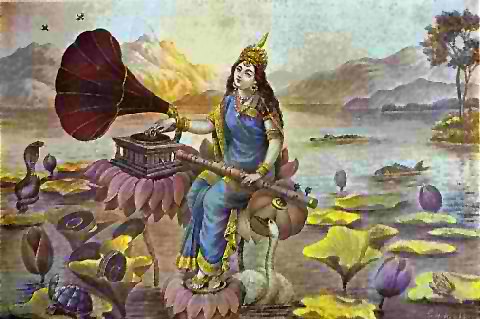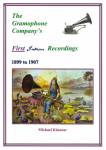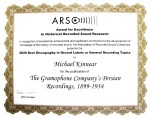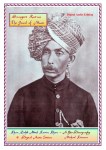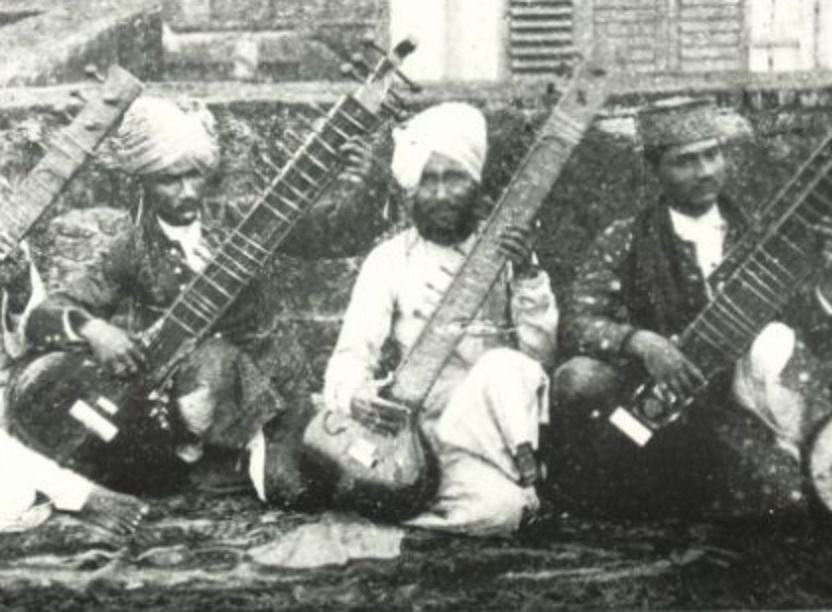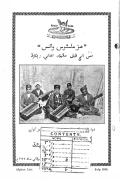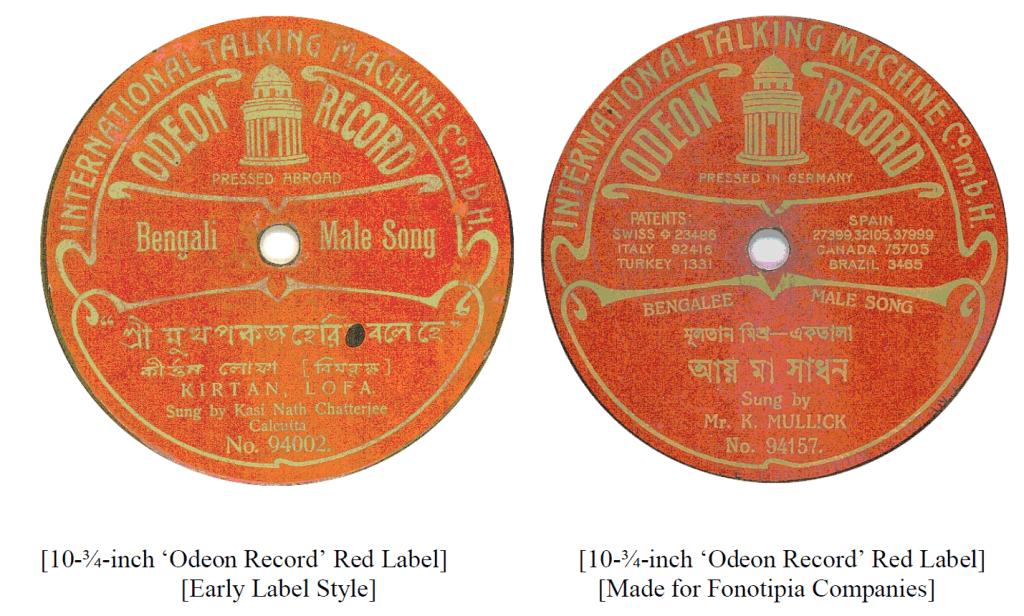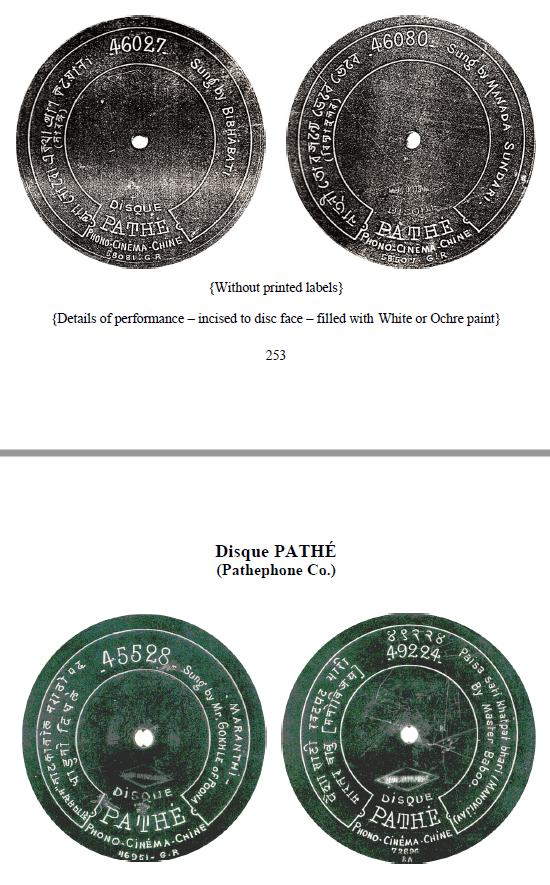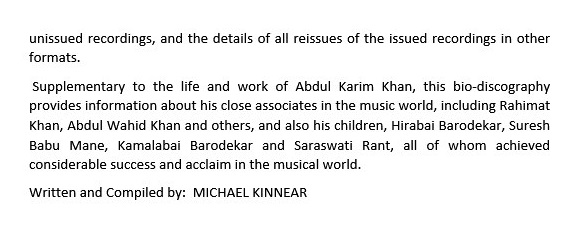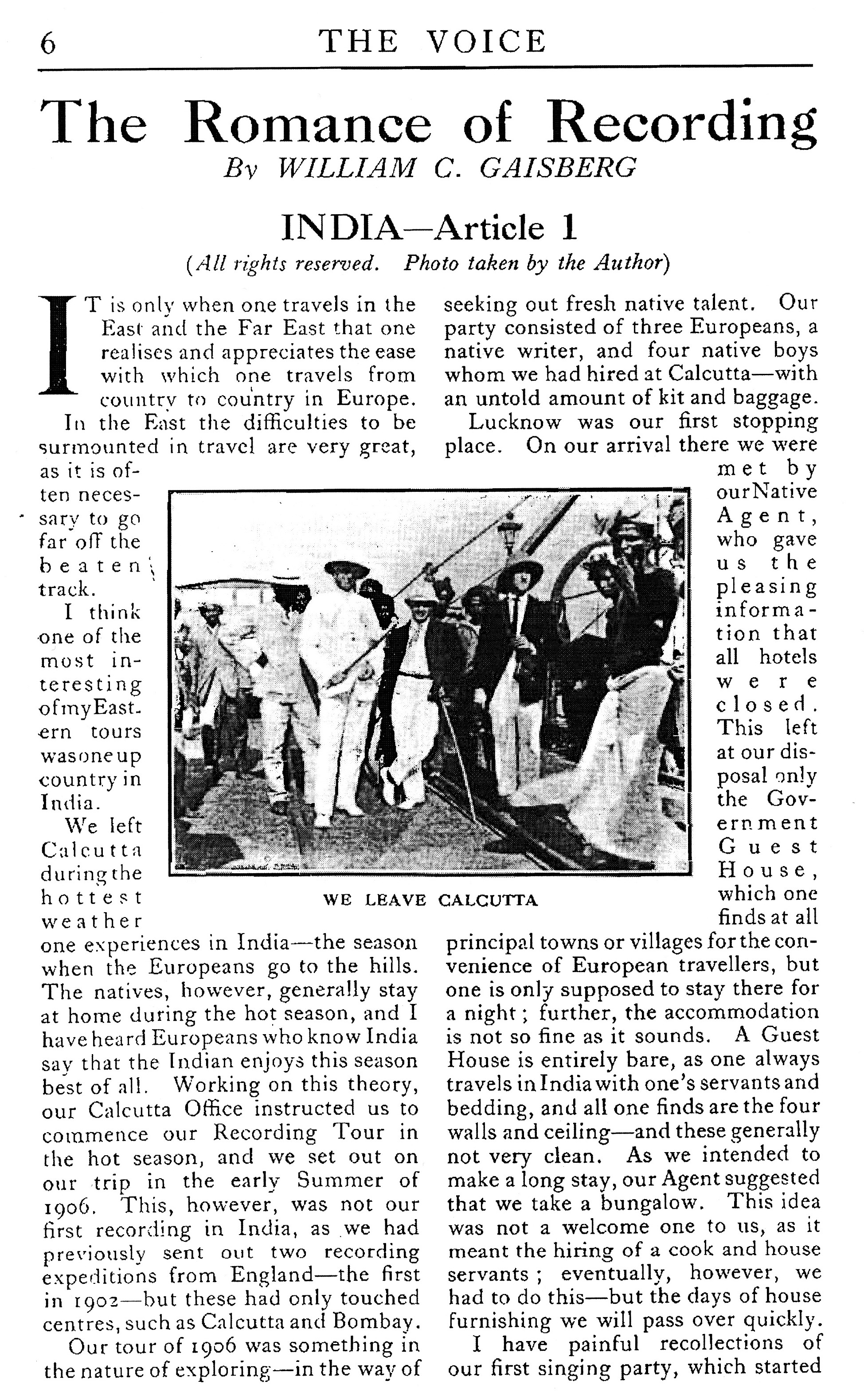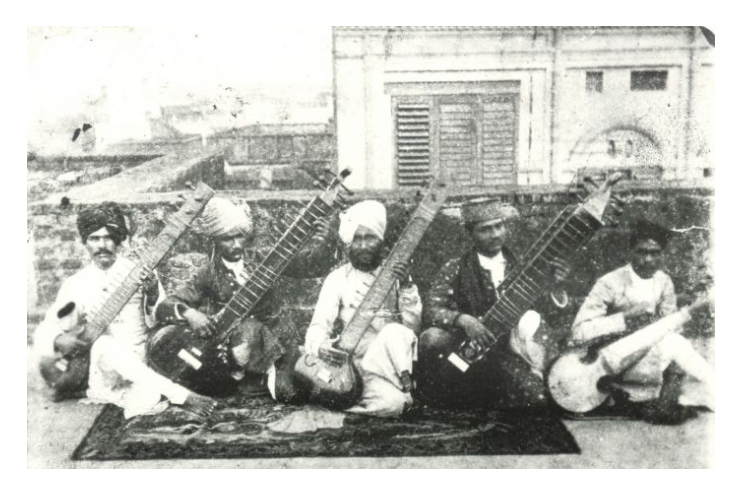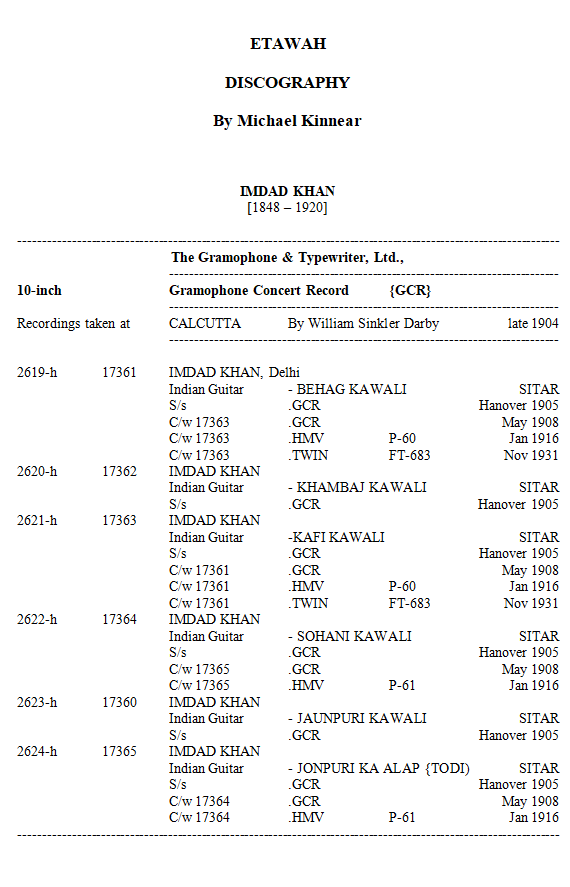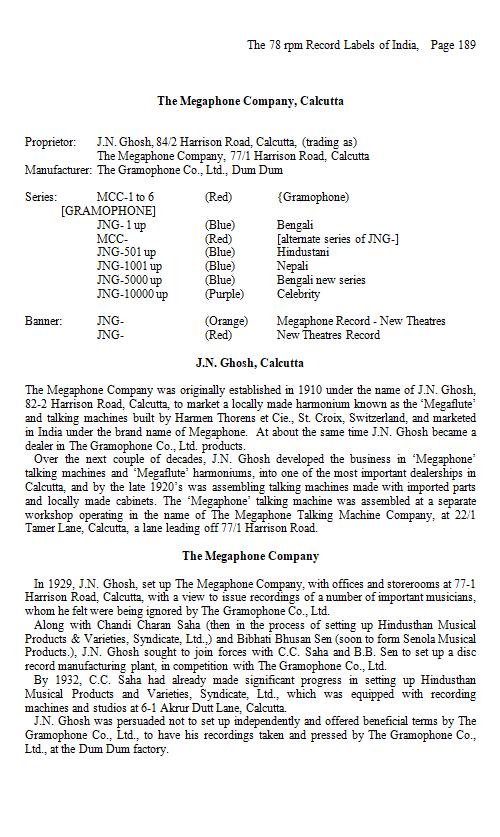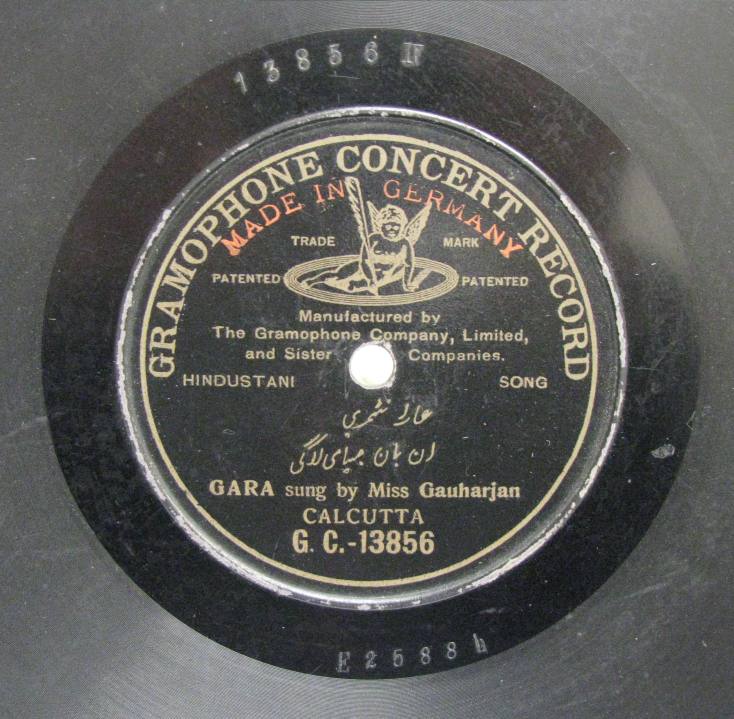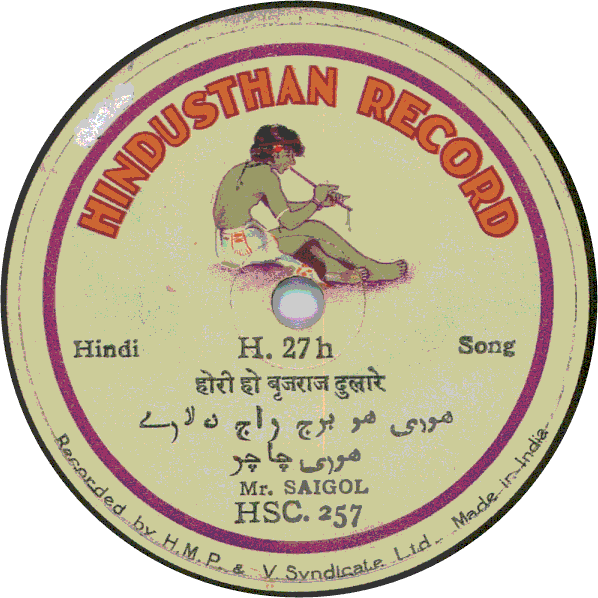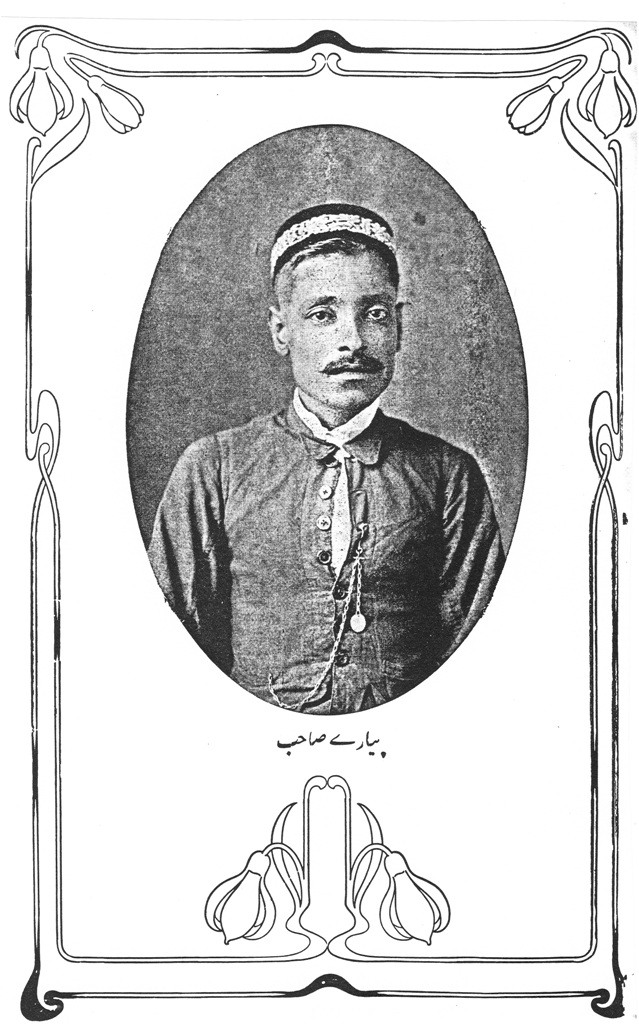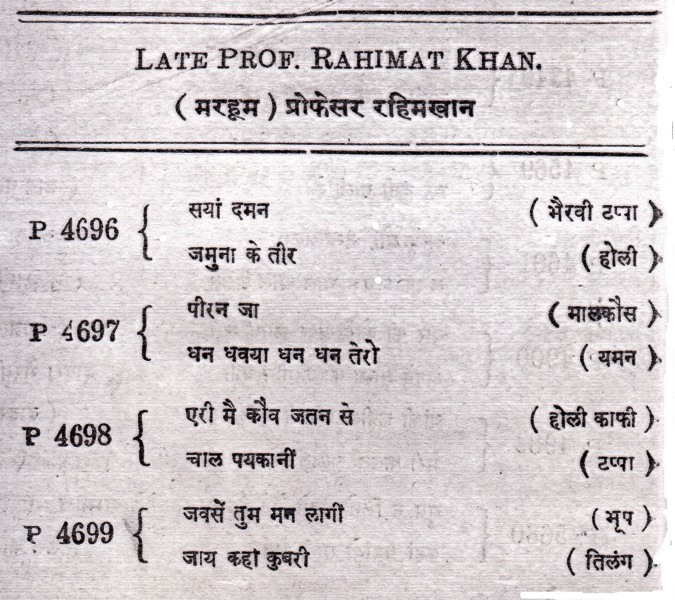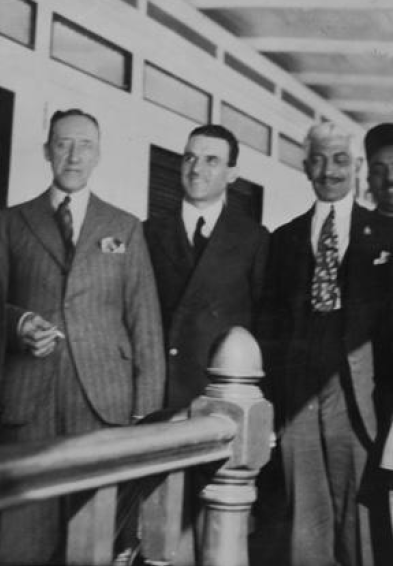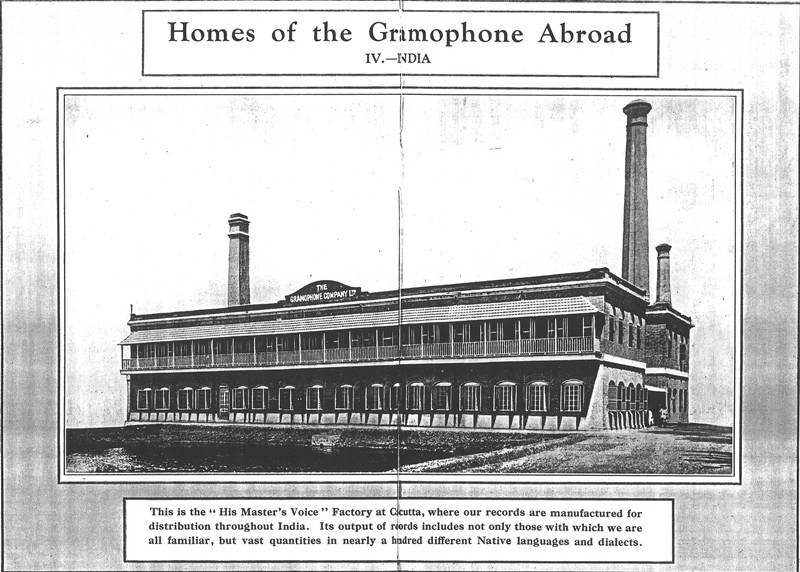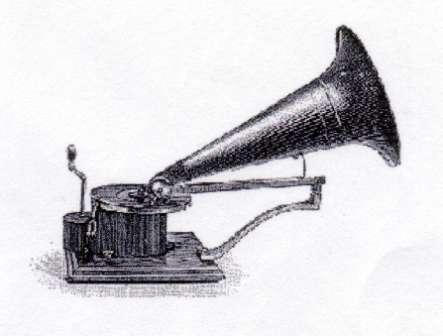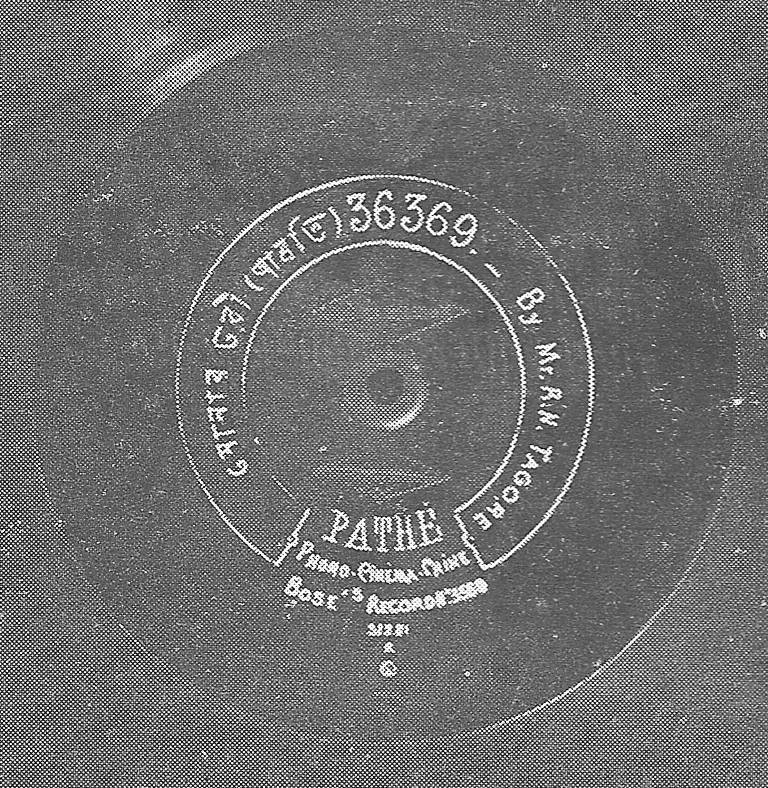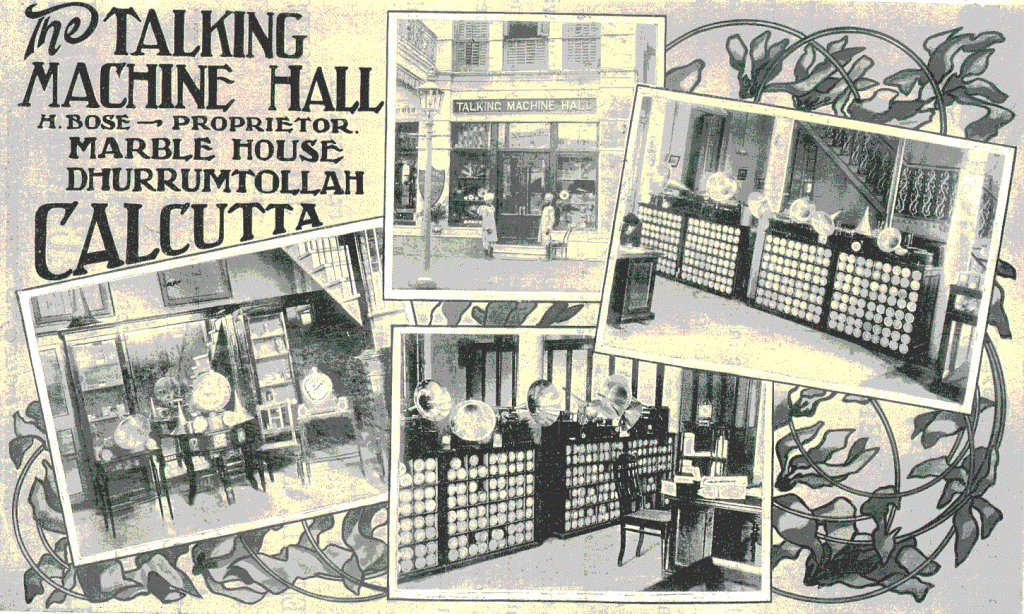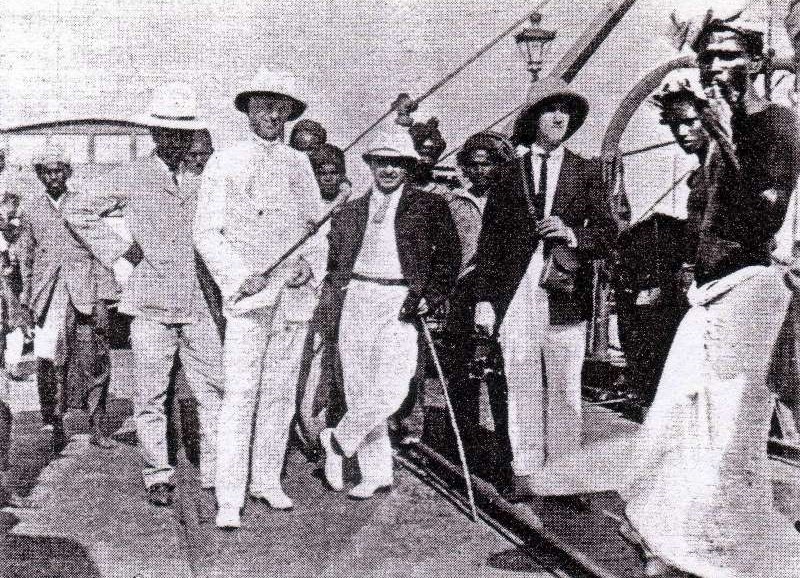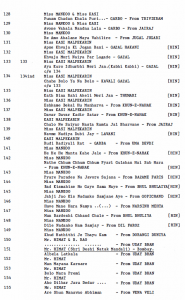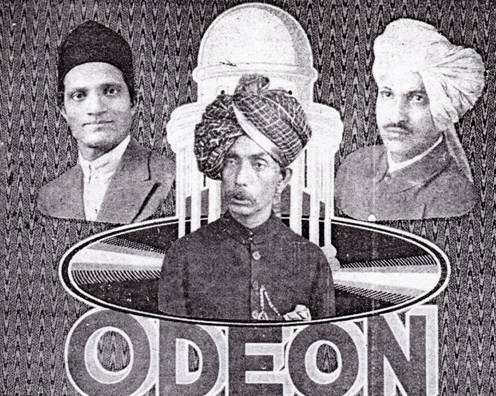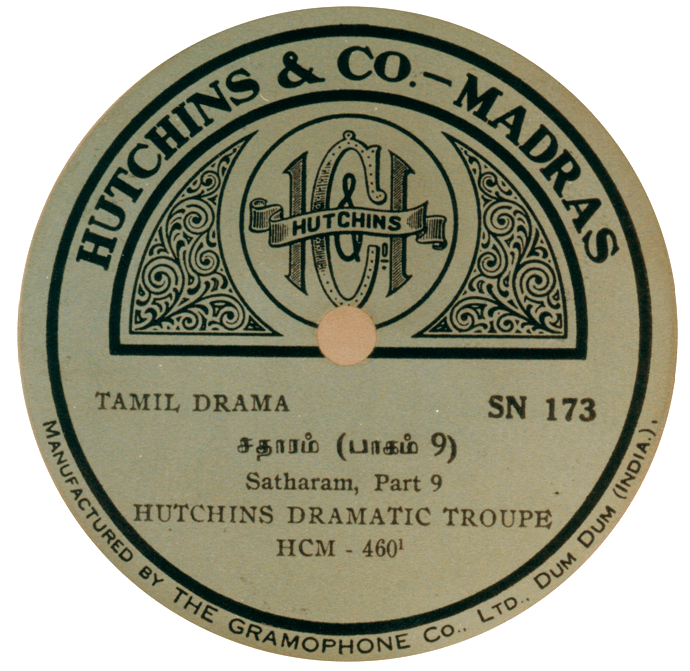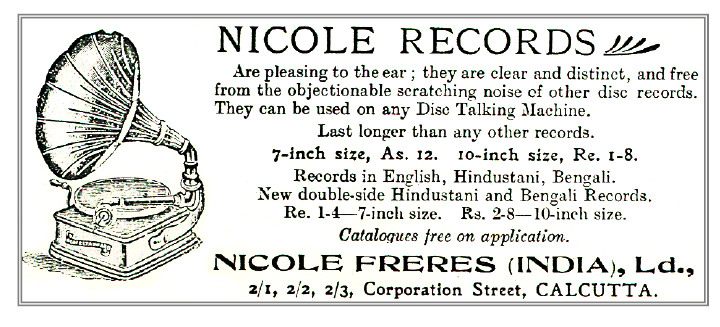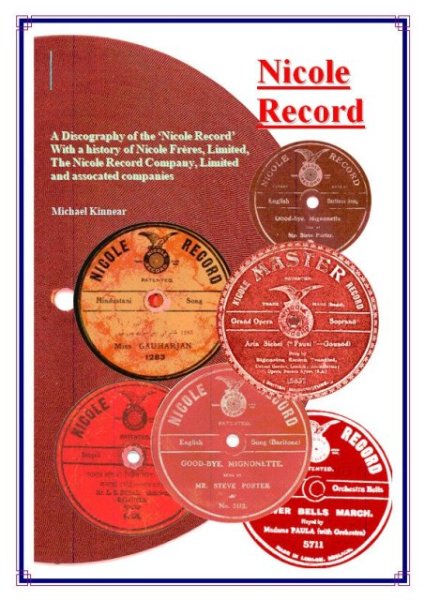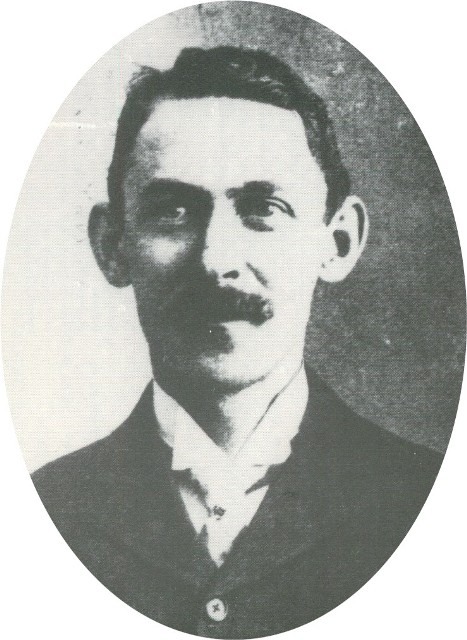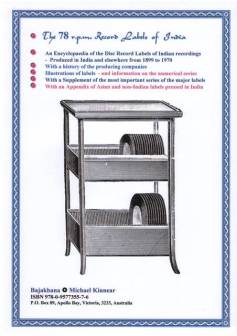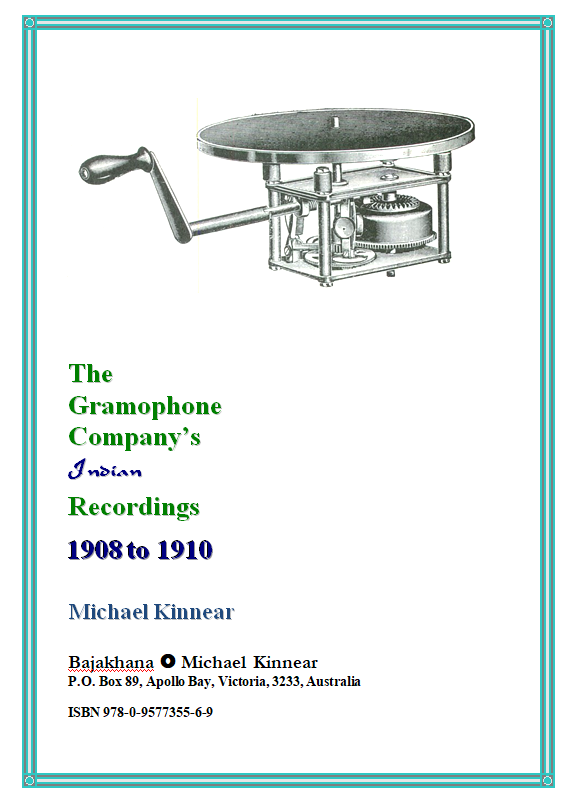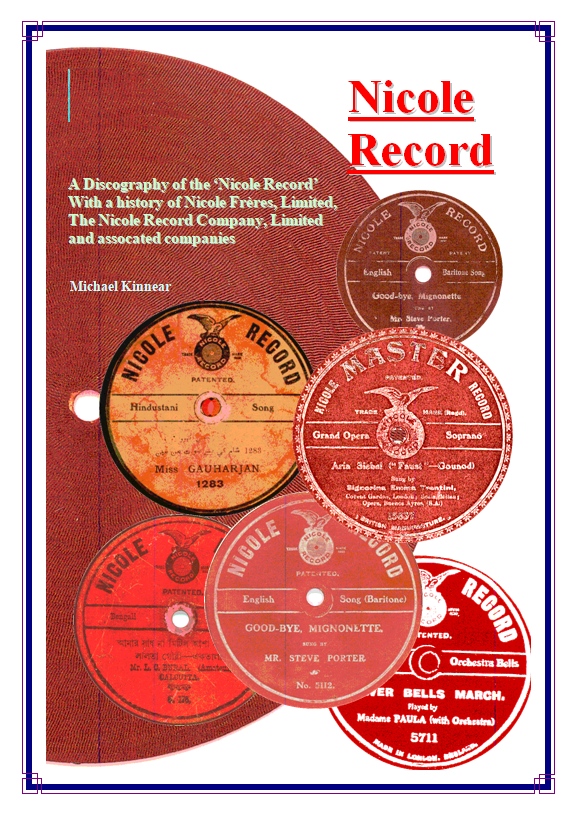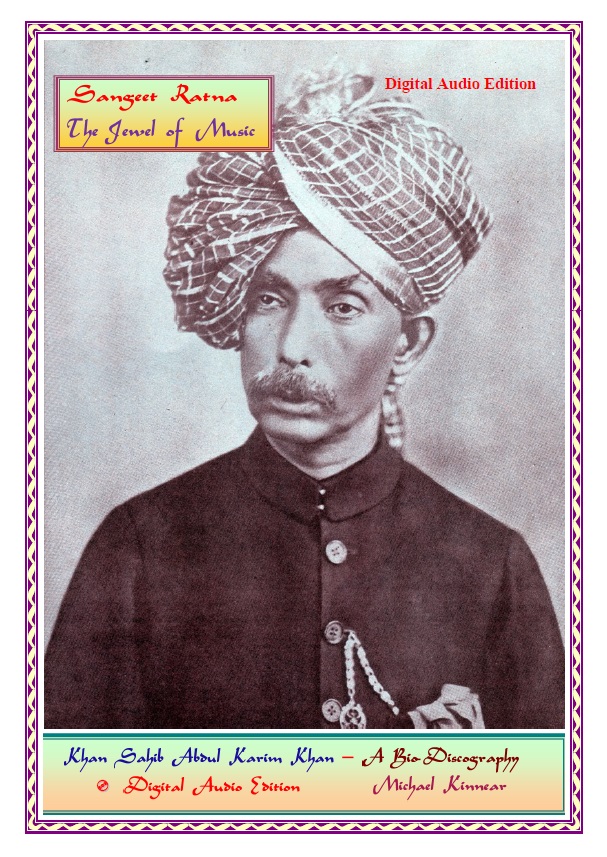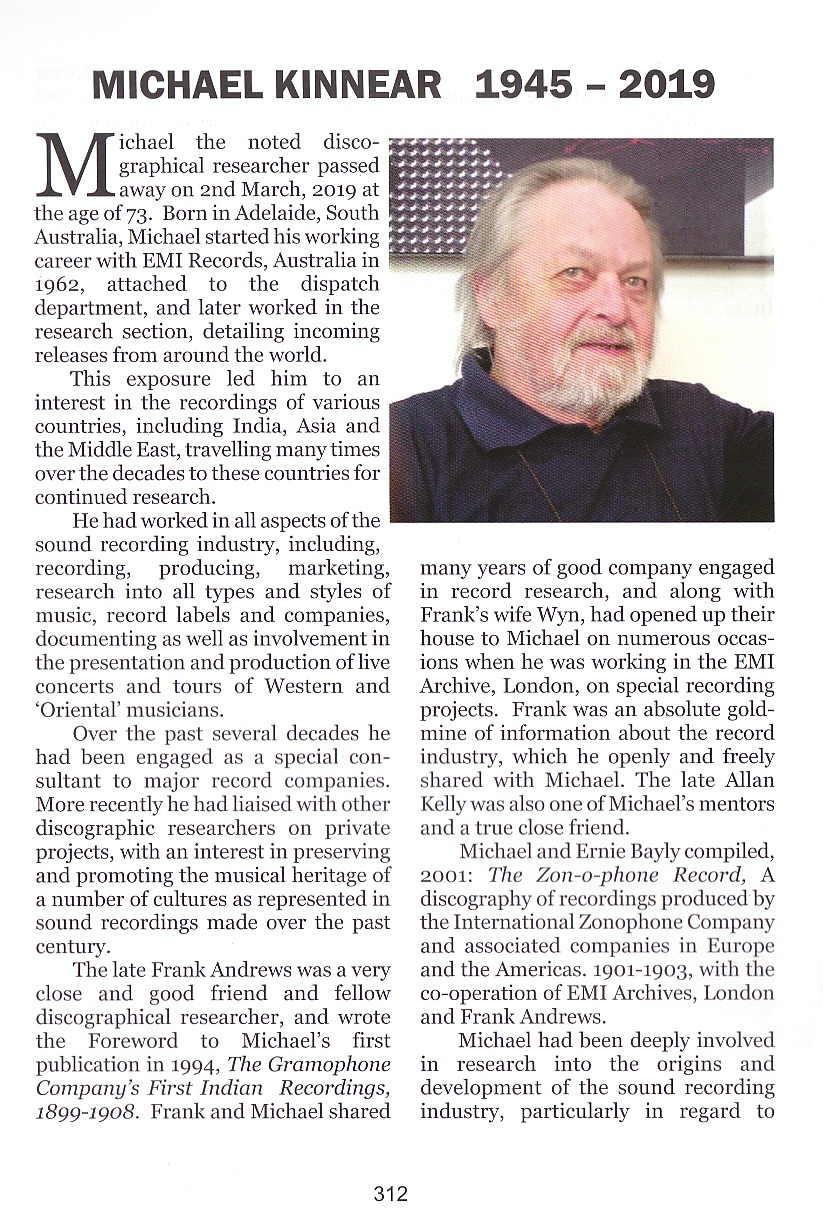‘Gramophone Saraswati’
The Gramophone and Typewriter Ltd.
‘Nagri’ Record Catalogue Cover, May 1907
Welcome to ‘bajakhana’, Michael Kinnear’s website into research on Indian and Persian sound recordings, along with research on early sound recording companies.
About the Author
MICHAEL KINNEAR (1945 – 2019) – a discographer and private researcher into the early sound recording industry with particular emphasis on documenting the Recording Industry of India, Asia and the Middle East and a discographic analysis of all sound recordings from these regions.
Born in Adelaide, South Australia, started his working career with EMI Records, Australia, in 1962, attached to the dispatch department, and later worked in the research section, detailing incoming releases from around the world. This exposure led him to an interest in the recordings of various countries, including India, Asia and the Middle East.
He had worked in all aspects of the sound recording industry, including, recording, producing, marketing, research into all types and styles of music, record labels and companies, as well as involvement in the presentation and production of live concerts and tours of Western and ‘Oriental’ musicians.
Over the past forty five years he had been deeply involved in research into the origins and development of the sound recording industry, particularly in regard to annotating the sound recordings of India, Asia and the Middle East, along with investigating which companies and manufacturers produced the recordings on a vast array of labels.
He has published several comprehensive discographies of early Indian Recordings and to detailing the activities of numerous sound recording expeditions and companies that have been active in India, Asia and the Middle East.
His published works include ‘A Discography of Hindustani and Karnatic Music’ ‘The Gramophone Company’s First Indian Recordings, 1899 to 1907’, ‘The Gramophone Company’s Indian Recordings 1908 to 1910’, ‘The 78 rpm Record Labels of India”, ‘The Gramophone Company’s Persian Recordings, 1899 to 1934’, ‘Nicole Record’ – ‘Sangeet Ratna – The Jewel of Music, a Bio-Discography of Khan Sahib Abdul Karim Khan’. He has also written and published ‘The Zon-o-phone Record’ in collaboration with Ernie Bayly.
In 1990, Michael along with Suresh Chandvankar helped establish The Society of Indian Record Collectors, in Mumbai, as a forum for other record collectors and music lovers to share their interest. Over the past several years, he has published numerous articles in “The Record News”, the Journal of the Society and a variety of journals with a specialized interest in sound recordings along with giving talks on the subject in Australia, England and India.
He had collected a large number of rare and unusual recordings as the result of numerous visits to India and other countries.
The primary main sources while living overseas of his research were from EMI Archives, London, The National Sound Archives, London, The British Library, Oriental and British Office Collections, London, The Gramophone Company of India Ltd., Dum Dum, also their offices in Mumbai, Kolkata and London and Phonothèque Nationale, Paris or out on some ‘field-trip’ in search of some long forgotten musician or recording artist, or persons connected with the sound recording industry.
More recently he had been engaged as a special consultant to major record companies and he had liaised with other discographic researchers on private projects, with an interest in preserving and promoting the musical heritage of a number of cultures as represented in sound recordings made over the past century. Very sadly, Michael Kinnear passed away in March 2019. 
Michael Kinnear on a Special Recording Project, EMI Music Archive, Hayes
ARSC Lifetime Achievement Award for Recorded Sound Research
Michael Kinnear, 2018
Association for Recorded Sound Collections recognizes Mr. Michael Kinnear for this lifetime commitment to documenting the early recordings of India and Persia, his co-founding of the Society of Indian Record Collectors, his numerous contributions to The Record News (Mumbai), and his numerous discographies on east Asian music, including: Discography of Hindustani and Karnatic Music (1985); The Gramophone Company’s Persian Recordings: 1899 to 1934 (2000); Discography of the Nicole Record with a History of Nicole Freres, Limited, The Nicole Record Company, Limited and Associated Companies (2001); The 78 r.p.m. Record Labels of India (2003, 2016); Sangeet Ratna, the Jewel of Music: A Bio-Discography of Khan Sahib Abdul Karim Khan (2003); The Gramophone Company’s First Indian Recordings 1899 to 1907 (1994, 2016) and The Gramophone Company’s Indian Recordings 1908 to 1910 (2000).
2017 ARSC Award for Excellence in Best Historical Research in Record Labels
Best Discography
The Gramophone Company’s First Indian Recordings, 1899-1907
Author: Michael Kinnear
♦ ISBN-10: 0-9577355-6-1
♦ ISBN-13: 978-0-9577355-6-9
The Gramophone Company’s Persian Recordings 1899-1934
Author: Michael Kinnear
♦ ISBN-10: 0-9577355-8-8
♦ ISBN-13: 978-0-9577355-8-3
2023 Nomination for ARSC Awards for Excellence in Historical Recorded Sound Research
Sangeet Ratna, The Jewel of Music
Khan Sahib Abdul Karim Khan, A Bio-Discography (PDF Format)
Author: Michael Kinnear
Digital Download Book
22 Digital Audio Recordings, MP3
A 90-minute collection of ODEON Out-takes and Test Pressings
♦ ISBN-10: 0-9577355-9-6
♦ ISBN-13: 978-0-9577355-9-0
A short film segment on Michael Kinnear from the Indian TV series “Gaata Jaaye Banjara” on the History of Indian Film Music. Cinema Vision India – 1990.
A True Friend and Companion
Juzer Varawalla, second left and Michael Kinnear, early days (1983) out on the road sourcing research photos of old Indian musicians from family relatives in India.
Books from Alavi Book Depot, Kalbadevi Road, Colaba, Mumbai
The ‘Michael Kinnear Collection’
Michael was extremely fortunate to have the encouragement and kindness of a close friend Juzer Tahir Varawalla who spoke several languages and acting as interpreter in conversations with people that Michael could not communicate with directly. Juzer-Bhai dealt in rare Islamic manuscripts and old Indian historic books and had his shop Alavi Book Depot in Kalbadevi Road, Colaba, Mumbai and this is how Michael met Juzer back in the early 1970’s. Juzer was Michael’s loyal and tireless companion “going on the road” pursuing research throughout India over many years, also opening his family home in Mumbai. The journeys took them to many cities and towns by rail from Kairana in the North to Mysore in the South. Juzer assisted with translation of song titles for some of the book publications. Very sadly Juzer-Bhai passed away in 2005.
Articles – by Michael Kinnear
On the Sound Recording Industry in India
WILLIAM CONRAD GAISBERG – THE VOICE – “The Romance of Recording”
THE VOICE “THE ROMANCE OF RECORDING” By William C. Gaisberg INDIA – Articles 1,2 and 3 Published from February, 1918. (Notes on the Article by Michael Kinnear) […]
The Grand Tradition – ETAWAH – DISCOGRAPHY
By Michael Kinnear. This ‘ETAWAH’ DISCOGRAPHY contains sound recordings only up until c. 1960. This is a limited ‘DISCOGRAPHY’ of the recordings made by the musicians Sahabdad Khan, Imdad Khan, Enayat Khan, Wahid Khan, Vilayat Khan & Imrat Khan […]
 MEGAPHONE RECORD – DISCOGRAPHY
MEGAPHONE RECORD – DISCOGRAPHY
In 1932, The Gramophone Co., Ltd., in India introduced a scheme known as ‘Private Recorders’ whereby local talking machine and record traders could have discs produced by the company, on their own labels. This meant that private companies were encouraged to access the recordings made by The Gramophone Co., Ltd., under contract, and have these recordings issued under their own labels. […]
 Musica G.D.
Musica G.D.
This article details how the Musica G.D. trademark imprint on record labels associated with Deutsche Grammophon-Aktiengesellschaft, Hanover and Polyphon-Musikwerke, Actiengesellschaft, Berlin came about and traces the history and use of the Musica G.D label imprint. An overview is given of the history of Georges Dutreih, a business established in 1835 in Paris under the name of Georges Dutreih, and many years later his son also named Georges (born 1858) who became the successor of the business. […]
Janki Nath Kumar reformed the business to market talking machines with the brand name of ‘Jien-o-phone’ and soon after became one of the primary dealers in Lahore of the products of The Gramophone Co., Ltd. With the introduction of the ‘private recorders scheme’ by The Gramophone Co., Ltd., in 1932, Janki Nath Kumar and Bros., became one of the major firms to join the scheme and market their own label in the name of the “Jien-o-phone Record”. […]
AFGHANISTAN – Early Recording Sessions
Early recording sessions of the Afghanistan repertoire conducted by The Gramophone Company Ltd., at the Hayes studios of The Gramophone Co., Ltd, London and the Indian branch of The Gramophone Co., Ltd.’s recording sessions at Lahore. Discography of Mr. Mirza Nazar Khan. […]
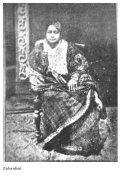 ZOHRA BAI – AGRAWALE DISCOGRAPHY.
ZOHRA BAI – AGRAWALE DISCOGRAPHY.
Zohra Bai of Agra is often referred to as one of the greatest singers of India performing at the turn of the century. Very little is known of her life and most references about her musical prowess appear to be more anecdotal than fact. According to some reports she was born in Agra in 1868, and received her musical training from Ahmad Khan a vocalist and sarangi player also of Agra. […]
 MISS GAUHAR JAN – DISCOGRAPHY.
MISS GAUHAR JAN – DISCOGRAPHY.
‘Perhaps the best selling ‘gramophone celebrity’ of the time, Miss Gauhar Jan of Calcutta, declined to be contracted to any recording company and provided her recordings to the various sound recording concerns on a strictly ‘cash’ basis – without any consideration for ‘royalties’ on sales, […]
MALKA JAN AGRAWALE – DISCOGRAPHY.
Malka Jan Agrawale of Agra and Calcutta. There is very little precise or factual information about the life of Miss Malka Jan Agrawale of Agra and Calcutta, but is said to be from Azamgarh in Uttar Pradesh a state in northern India. […]
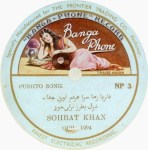 BANGA-PHONE RECORD – Discography. The Frontier Trading Company, Peshawar.
BANGA-PHONE RECORD – Discography. The Frontier Trading Company, Peshawar.
In 1932, The Gramophone Co., Ltd., in India introduced a scheme known as ‘Private Recorders’ whereby local talking machine and record traders could have discs produced by the company, on their own labels. […]
 GULSHAN – Discography. Bajaj & Co., (Nowshera) Peshawar.
GULSHAN – Discography. Bajaj & Co., (Nowshera) Peshawar.Prior to the partition of India in 1947 and the creation of Pakistan (East and West), Lahore was a major recording centre for the North-west region, with the earliest recordings being taken there in 1905 by The Gramophone & Typewriter, Ltd. […]
SHAHENSHAHI RECORD. The Talking Picture Record Co. – .History and Discography.
The Talking Picture Record Co. was established at Rangoon, Burma, by H.E. Patel (or Mohammed Salim) during 1933, and was one of the first clients to join the ‘Private recorders’ scheme offered by The Gramophone Co., Ltd. The first releases of The Talking Picture Record Co. were Burmese recordings on the “Bandoola” label, and Hindustani recordings on the “Shahenshahi Record ” label were made in June 1933. […]
K. L. SAIGAL DISCOGRAPHY. The recordings of K.L. Saigal have remained popular since the first release of – H27h – in February 1933, and by and large the majority of K.L. Saigal’s recordings have remained on the catalogues of Hindusthan Musical Products (and Varieties Syndicate) Ltd., or The Gramophone Company (of India) Ltd, [….]
 PEARA SAHEB – A Bio-Discography. Peara Saheb, Gazal, Thumri and Dadra Vocal music, a bio-discography. There is very little precise or factual information about the life of Peara Saheb. No documentation has been sited to confirm his date of birth or death, […]
PEARA SAHEB – A Bio-Discography. Peara Saheb, Gazal, Thumri and Dadra Vocal music, a bio-discography. There is very little precise or factual information about the life of Peara Saheb. No documentation has been sited to confirm his date of birth or death, […]
CONGRÈS DE MUSIQUE ARABE DU CAIRE 1932– Discography. (The Cairo Congress of Arab Music) 28th March to 3rd April 1932. Discography compiled by Michael Kinnear. A complete numerical catalogue, by matrix serials of the 78 rpm recordings from the Congrès de Musique Arabe […]
GRAMOPHONE RECORD, ZONOPHONE,
Reading Indian Record Labels – Part 1.Originally Published January 1991. Revised and updated. Part One – “GRAMOPHONE” and ZONOPHONE Records. Most collectors of Indian recordings issued as 78 rpm discs collect such records for the musical piece that the record contains whether such records are single-side recorded discs or double-sided discs. Apart from the interest in the song[…]
NICOLE RECORD, Reading Indian Record Labels – Part 2. Originally Published April 1991, Revised and updated. Part Two – ‘NICOLE RECORD’. The ‘NICOLE RECORD’ is amongst the rarest of record labels with an Indian repertoire, and with it’s introduction to the disc record market in India by mid-1905, this – brown, celluloid coated, cardboard disc record – was only the […]
BEKA RECORD,Reading Indian Record Labels – Part 3. Originally Published 3 July 1991, Revised and updated. Part Three – ‘BEKA RECORD’. The name BEKA – is derived from the surname initial of the founders of the Beka Record G.M.b.H., namely Heinrich Bumb and Max Koenig, who had started in business in Berlin in about 1900 as merchants of Edison […]
 BEKA RECORD DISCOGRAPHY
BEKA RECORD DISCOGRAPHY
Indian Repertoire
By Michael Kinnear- 31 page Discography included in the “Article” BEKA RECORD, Reading Indian Record Labels – Part 3
DISCOGRAPHY – Beka Record, Beka Grand Record, Discography, Indian Repertoire pdf.
ODEON RECORD and ODEON,Reading Indian Record Labels – Part 4.
Originally Published October 1991. Revised and updated. Part Four – ‘ODEON RECORD and ODEON’. I have written a comprehensive article on the history of the ODEON RECORD and later ODEON labelled discs that were recorded and placed on the market in India between 1908 and 1940, under the title ODEON IN[…]
PATHÉ and PATHEPHONE, Reading Indian Record Labels – Part 5.
Originally Published April 1992. Revised and updated. Part Five – ‘PATHÉ and PATHEPHONE’. ‘PATHÉ’ or ‘PATHEPHONE’ as a disc record label in India is one of the rarest of disc records to feature an Indian repertoire. The first PATHE disc records with an Indian Repertoire were placed on the market in India in […]
 SUN DISC RECORD, Reading Indian Record Labels – Part 6.
SUN DISC RECORD, Reading Indian Record Labels – Part 6.
Originally Published July 1993. Revised and updated. Part Six – SUN DISC RECORD. The SUN DISC RECORD was introduced in India in 1909 by F,B, Thanewalla and Co., of 143 Kalbadevi Road, Bombay, and 13 Esplanade East, Calcutta, as an additional product to market in support of the trade in cycles that […]
SINGER RECORD and JAMES OPERA RECORD Reading Indian Record Labels – Part 7.
Originally Published, October 1994. Revised and updated. Part Seven – SINGER RECORD and JAMES OPERA RECORD, THE WELLINGTON CYCLE CO. The Wellington Cycle Co., was established in 1901 by Rustomjee Dorabjee Wellington (Anglicized from his Parsi name Rustomjee Dorabjee) assisted by T. Dorabjee and R. Dorabjee. The Wellington Cycle Co., had taken […]
RAMAGRAPH, RAM-A-PHONE DISC RECORDS – Reading Indian Record Labels – Part 8.
Originally Published, October 1995. Revised and updated. Part Eight – RAMAGRAPH. The History of the RAM-A-PHONE and RAMAGRAPH Disc Records. Among the very numerous record companies and their labels that have been active over the past several decades of sound recording, a very neglected area of research, apart from the […]
 BROADCAST IN INDIA, English Manufactured Indian Record Labels.
BROADCAST IN INDIA, English Manufactured Indian Record Labels.
Revised and Updated Originally Published October, 1990 in the journal of The HILLANDALE NEWS, the official journal of The City of London Phonograph and Gramophone Society London, England […]
THE FIRST INDIAN DISC RECORD MANUFACTURERS, Royal Record, Binapani Record, Kamala Record.
Originally Published January 1992. Revised and updated. A research enquiry concerning the ROYAL RECORD, BINAPANI RECORD, KAMALA RECORD. This article attempts to piece together the history of the FIRST Indian disc record manufacturers from […]
 ENGLISH RECORDINGS IN THE INDIAN CATALOGUE
ENGLISH RECORDINGS IN THE INDIAN CATALOGUE
Part One, Part Two.
Part ONE– ENGLISH INDIAN GRAMOPHONE NUMBERS By Frank Andrews and Michael Kinnear, originally Published April 1992
Part TWO – “ENGLISH” RECORDINGS IN THE INDIAN CATALOGUE by Michael Kinnear – Published in ‘The 78 rpm Record Labels of India’ with updated information on the above article ‘English Indian Gramophone Numbers’ […]
 RAHIMAT KHAN – KHYAL SINGER c. 1860 – 1922 RECORDINGS – DISCOGRAPHY.
RAHIMAT KHAN – KHYAL SINGER c. 1860 – 1922 RECORDINGS – DISCOGRAPHY.By Michael Kinnear, originally Published 2003 in “Sangeet Ratna – The Jewel of Music” Khan Sahib Abdul Karim Khan – A Bio Discography Rahimat Khan with Vishnupant […]
Please refer to the Articles Page for a full list and downloads available
ARSC 2023 Nomination for Awards for Excellence in Historical Recorded Sound Research
Online Release as Colour Digital PDF
2nd Edition with Twenty-two previously unissued Digital Audio files
‘Sangeet Ratna, The Jewel of Music, Khan Sahib Abdul Karim Khan
A Bio-Discography’
(PDF Format)
“Dira Dira Ta Noma – MARWA TARANA” by Abdul Karim Khan -ODEON Out-takes and Test Pressings, 1934-36.
“Aba Maine Dedkari – VASANT KHYAL” By Abdul Karim Khan – ODEON – Out-takes and Test Pressings, 1934-36.
MUSICA G.D.
“Phonographes “Dutreih”, Musica G.D, Paris, Appareils à Cylindres et à Disques
Catalogue 1910
Musica G.D.
-
- Abstract:
This article details how the Musica G.D. trademark imprint on record labels associated with Deutsche Grammophon-Aktiengesellschaft, Hanover and Polyphon-Musikwerke, Actiengesellschaft, Berlin came about and traces the history and use of the Musica G.D label imprint. An overview is given of the history of Georges Dutreih, a business established in 1835 in Paris under the name of Georges Dutreih, and many years later his son also named Georges (born 1858) who became the successor of the business. On 30th March 1904, Georges Dutreih et Cie., Paris, was granted the registration of a trademark depicting a star with the words ‘Musica G.D. Paris’ upon it. On the 28th January 1921, the Musica G.D. trademark was assigned to the German company Polyphon-werke A.G., 76 Markgrafenstrasse, Berlin, who utilised the Musica G.D. trademark as their holding company to expand and market products outside of Germany. To accomplish this task an umbrella company was organised for the ‘export market’ in the name of MusicaG.D. In 1929 the use of the Musica G.D. trademark became redundant.
- Copyright of ARSC Journal is the property of Association for Recorded Sound Collections.
- Abstract:
Updated Article
THE VOICE
“THE ROMANCE OF RECORDING”
By William C. Gaisberg
INDIA – Articles 1,2 and 3
Published from February, 1918.
(Notes on the three Articles of ‘The Voice” by Michael Kinnear)
This series of articles under the title of – “The Romance of Recording” – by William C. Gaisberg, were published in – “THE VOICE” – the house magazine of The Gramophone Company, Ltd., Hayes, England, in three instalments from February 1918, and have been reprinted here by permission of EMI Archive Trust. This is an updated version of the original article previously published in 1995.
William Conrad Gaisberg, “Recording Expert” for The Gramophone Company, Ltd.
Photo: “The Gramophone Company’s First Indian Recordings, 1899-1907″
Author: Michael Kinnear, Page 33
WILLIAM CONRAD GAISBERG (1878 – 1918) was the younger brother of Frederick William Gaisberg (1873 – 1951) and like his elder brother was a ‘recording expert’ of The Gramophone Company, Ltd. Will Gaisberg’s recording activity was essentially confined to Europe, but during 1906 and 1907 he conducted a recording tour, assisted by George Walter Dillnutt on behalf of The Gramophone & Typewriter, Ltd., to India, Japan and Korea, from May 1906 through to March 1907.
The narrative of his recording tour of India describes the first half of his ‘expedition’ to India beginning at Calcutta during May 1906 in these 3 Articles.
 LINK for the Full Article
LINK for the Full Article
“The Romance of Recording” William C. Gaisberg
THE GRAND TRADITION
‘ETAWAH’
GHARANA
DISCOGRAPHY
By Michael Kinnear
This ‘ETAWAH’ DISCOGRAPHY contains sound recordings only up until c. 1960. This is a limited ‘DISCOGRAPHY’ of the recordings made by the musicians.
2nd Left: Enayat Khan, Centre: Imdad Khan, 2nd Right Wahid Khan
(c. 1910, Calcutta)
KHAN FAMILY MEMBERS OF THE ‘ETAWAH’ GHARANA
The Gramophone Co. Ltd., Calcutta, HMV G.C.-17361, Imdad Khan
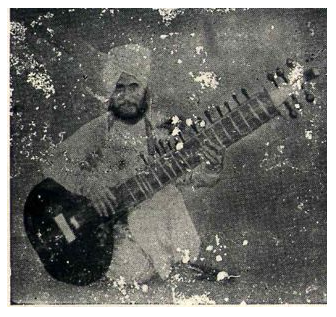 LINK for the Full Article – The Grand Tradition ETAWAH-DISCOGRAPHY
LINK for the Full Article – The Grand Tradition ETAWAH-DISCOGRAPHY
MEGAPHONE RECORD
The history of ‘MEGAPHONE RECORD’ taken from:
‘The 78 rpm Record Labels of India’
‘MEGAPHONE RECORD’ DISCOGRAPHY
Previously unpublished – from the ‘Michael Kinnear Archives’
- 10″ – Swadeshi Record
- 9″ – Megaphone Junior
In 1932, The Gramophone Co., Ltd., in India introduced a scheme known as ‘Private Recorders’ whereby local talking machine and record traders could have discs produced by the company, on their own labels.
This meant that private companies were encouraged to access the recordings made by The Gramophone Co., Ltd., under contract, and have these recordings issued under their own labels, as if in competition to HIS MASTER’S VOICE, COLUMBIA, and ODEON.
Along with Valabhdas Runchordas, other entrepreneurs, including Chandi Charan Saha [Hindusthan Musical Products & Varieties, Syndicate, LTD., Calcutta], J. N. Ghosh [The Megaphone Company, Calcutta], and Bibhati Bhushan Sen [Senola Musical Products, Calcutta] were also keen to set up their own disc record pressing factories, but were persuaded by The Gramophone Co., Ltd., to have their disc records made by the Dum Dum factory, with releases being marketed by these companies from 1932-33 onwards.
The most important of these ‘Private Recorders’ was The Megaphone Company with the ‘MEGAPHONE RECORD’.
LINK for the Full Article – Megaphone Record
‘JIEN-O-PHONE RECORD’
The history of ‘JIEN-O-PHONE RECORD’ taken from:
‘The 78 rpm Record Labels of India’
- JP. 501 Master Rahmat
- RB. 202 Raj Kumar Dramatic Party
Janki Nath Kumar established Janki Nath Kumar and Bros., in the early 1920’s with a store in the Anarkali Bazar, Lahore. Janki Nath Kumar, was in fact succeeding a business that had been established by his father in 1898, in the name of Dwarka Nath and Co., as a dealer in musical instruments, Clocks and Watches.
Janki Nath Kumar reformed the business to market talking machines with the brand name of ‘Jien-o-phone’ and soon after became one of the primary dealers in Lahore of the products of The Gramophone Co., Ltd.
With the introduction of the ‘private recorders scheme’ by The Gramophone Co., Ltd., in 1932, Janki Nath Kumar and Bros., became one of the major firms to join the scheme and market their own label in the name of the “Jien-o-phone Record”. The first releases on the “Jien-o-phone Record” label were issued in the RB-201 (12”) and JP- 501 (10”) series in December 1933.
COLUMBIA RECORDS CATALOGUE – 1946
‘JIEN-O-PHONE RECORD’ DISCOGRAPHY
Unpublished – from the ‘Michael Kinnear Archives’
LINK for the Full Article – Jien-o-phone Record
AFGHANISTAN
The Early Recording Sessions
Early recording sessions of the Afghanistan repertoire conducted by The Gramophone Company Ltd., at the Hayes studios of The Gramophone Co., Ltd, London and the Indian branch of The Gramophone Co., Ltd.’s recording sessions at Lahore.
The above photo is the cover of The Gramophone Co. Ltd.’s Afghanistan June, 1926 catalogue, featuring the rubāb player Qurban Ali in the group of Ustad Qasim Afghan. Qurban Ali is seated on the right with his rubāb instrument. Ustad Qasim Afghan is seated centre.
With the changing political situation in Persia and Iraq, The Gramophone Company, Ltd., renewed its interest in the region and reorganized its territorial control by sharing resources with the Indian branch office. The head office in London undertook control of the Persian and Iraqi recording sessions, while the Indian branch undertook recording sessions in Lahore of Afghani musicians. During 1925 and early 1926, musicians were brought over from Kabul, Afghanistan, and from Peshawar in the North West Frontier Provinces of India, for recording sessions held at Lahore.
The Gramophone Company Ltd.’s Afghanistan Catalogue
July, 1928
P-14010 to P-14014
P-17501
10 inch His Master’s Voice
LINK for the Full Article – Afghanistan
ZOHRA BAI – AGRAWALE
Recordings for the ‘Gramophone’
Accredited as Zohra Bai: Photo Courtesy: Patrick Moutal Site – Indian Music
11789o 8-13604 ZOHRA BAI
Tarana – BHUPALI [HINDUSTANI]
13705o 8-13996 ZOHRA BAI
Chatur Sugar Baiyan Pakrat Ho – KHIAL KEDARA [HINDUSTANI]
 Zohra Bai of Agra is often referred to as one of the greatest singers of India performing at the turn of the century. Very little is known of her life and most references about her musical prowess appear to be more anecdotal than fact. According to some reports she was born in Agra in 1868, and received her musical training from Ahmad Khan a vocalist and sarangi player also of Agra. Ahmad Khan is reported to have learnt dhrupad and dhamar styles from Ghulam Abbas Khan (1825–1934?) one of the progenitors of the Agra Gharana. Ahmad Khan is also said to have learnt kheyal from Mehbub Khan Daras (1845-1922?) of Atrauli. It is also related that Ahmad Khan had a particular fondness for Zohra Bai, and had trained her her to maturity.
Zohra Bai of Agra is often referred to as one of the greatest singers of India performing at the turn of the century. Very little is known of her life and most references about her musical prowess appear to be more anecdotal than fact. According to some reports she was born in Agra in 1868, and received her musical training from Ahmad Khan a vocalist and sarangi player also of Agra. Ahmad Khan is reported to have learnt dhrupad and dhamar styles from Ghulam Abbas Khan (1825–1934?) one of the progenitors of the Agra Gharana. Ahmad Khan is also said to have learnt kheyal from Mehbub Khan Daras (1845-1922?) of Atrauli. It is also related that Ahmad Khan had a particular fondness for Zohra Bai, and had trained her her to maturity.
ZORA BAI – AGRAWALE
DISCOGRAPHY
by Michael Kinnear
LINK for the Full Article – Zohra Bai Agrawale
MISS GAUHAR JAN
DISCOGRAPHY
by Michael Kinnear
Gauhar Jan, Seated Center, with Nautch Girls, c.1800’s
Courtesy: Columbia University in the City of New York
Miss Gauhar Jan
Fron: The Gramophone Company’s First Indian Recordings, 1899-1907
Author: Michael Kinnear, Page 142
Michael Kinnear Collection
Miss Gauhar Jan – Raga Malhar – 1906
‘Miss Gauhar Jan (born Angelina Yeoward; 26 June 1873 – 17 January 1930) was an Indian singer and dancer from Kolkata. She was one of the first performers to record music on 78 rpm records in India, which was later released by The Gramophone Company Ltd., of India. Having recorded more than 600 songs in more than ten languages between 1902 and 1920, Gauhar Jan is credited with popularizing Hindustani classical music such as thumri, dadra, kajri, and tarana during the period.’ (Wikipedia)
‘Perhaps the best selling ‘gramophone celebrity’ of the time, Miss Gauhar Jan of Calcutta, declined to be contracted to any recording company and provided her recordings to the various sound recording concerns on a strictly ‘cash’ basis – without any consideration for ‘royalties’ on sales, this is despite the fact that some of her recordings may well have sold in very considerable quantities.’
Gauhar Jan with her accompanying musicians standing by to participate in the recital.
‘Michael Kinnear Collection’
GAUHAR JAN DISCOGRAPHY
Compiled by Michael Kinnear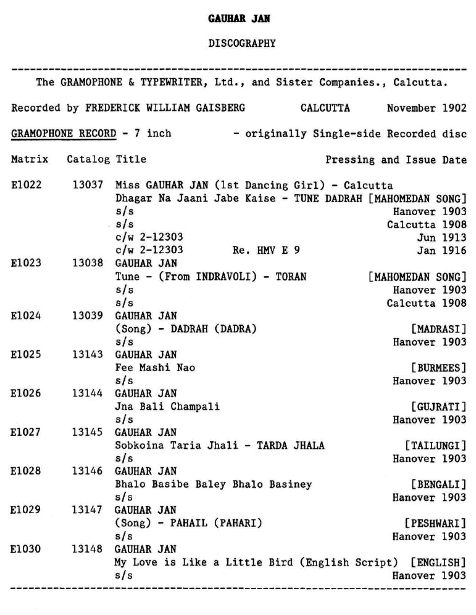
MALKA JAN AGRAWALE of Agra and Calcutta
DISCOGRAPHY
by Michael Kinnear
Malka Jan Agrawale
Malka Jan Agrawale of Agra and Calcutta
The Gramophone Company Ltd. Nagri Catalogue, March, 1908
from: “The Gramophone Company’s Indian Recordings,1908-1910”, Page 119
Malka Jan Agrawale of Agra and Calcutta, Raga Mand: DADRA, 1909
The announcement at the end of the above recording: “My name is Malka Jan of Calcutta”.
Malka Jan, Raga Sawan: DADRA, 1909
The announcement at the end of the above recording: “My name is Malka Jan of Agra”.
There is very little precise or factual information about the life of Miss Malka Jan Agrawale of Agra and Calcutta, but is said to be from Azamgarh in Uttar Pradesh a state in northern India.
Malka Jan developed a new style of thumri singing using the full power of ones voice. Proficient and accomplished in different musical formats, from dhrupad, khayal, to thumri, she was equally adept at hori chaite kajri and ghazal singing. At the end of each record Malka Jan announced: “My name is Malka Jan” and either from Agra or Calcutta.
‘Exclusive Contracts’
Quote from: “The Gramophone Company’s Indian Recordings, 1908-1910”, Page 8
“Of major concern to The Gramophone & Typewriter, Ltd., was the fact that several of their best selling artists were providing recordings to the rival companies, including a selection of the same songs that were available as ‘Gramophone’ labelled discs. While it is also true that some artists had also provided recordings to other recording companies – before they were recorded by The Gramophone & Typewriter, Ltd., the company took the view that the only way to control these artists was to try and commit the best artists to an ‘exclusive’ recording contract, thereby eliminating the opportunity of the better artists offering their talents to the rival companies.
The first artists to be contracted as ‘exclusive’ recording artists of The Gramophone & Typewriter, Ltd., were Peara Saheb of Calcutta, and Miss Malka Jan of Agra. ”
It is documented by The Gramophone Company & Typewriter, Ltd. that Miss Malka Jan Agrawale resided at 27 Mott’s Lane, Calcutta in 1907 and had a “Contract” to record with “The Gramophone & Typewriter, Ltd.” dated 14 February 1907.
MALKA JAN DISCOGRAPHY
“BANGA-PHONE” RECORD
The Frontier Trading Company, Peshawar
History from ‘The 78 rpm Record Labels of India’
by Michael Kinnear, 2nd Edition Published 2016
BANGA-PHONE DISCOGRAPHY
by Michael Kinnear
 “Banga-Phone” Record – Blue Label Series – Pushto and Gurmukhi
“Banga-Phone” Record – Blue Label Series – Pushto and Gurmukhi
‘The 78 rpm Record Labels of India’, Pages 19
“Banga-Phone” Record – Trademark
In 1932, The Gramophone Co., Ltd., in India introduced a scheme known as ‘Private Recorders’ whereby local talking machine and record traders could have discs produced by the company, on their own labels.
Amongst the ‘Private Recorders’ were Janki Nath Kumar & Bros., of Lahore (“Jien-o-phone Record”); The Frontier Trading Co., of Peshawar (“Banga-phone Record”); Bajaj & Co., of Peshawar (“Gulshan”) the West End Phono, of Lahore (“New Excelsior Record”) and a couple of smaller traders.
One of the traders to participate in this scheme were Gurdit Singh and Jiwan Singh Banga, trading as The Frontier Trading Co., of Peshawar. An agreement was signed between the two parties on the 1st October, 1934. The label introduced by the Banga brothers in 1934, was the “Banga-Phone Record” which included Kashmiri, Pushto, Gurmukhi and Persian repertoires.
From 1932 through to 1946, recording sessions of performers from the North-West Frontier Provinces, of Persian, Pushto, Kashmiri, Multani and Afghani repertoires, were essentially organised by The Frontier Trading Co., of Peshawar. The recording sessions were usually held at Delhi or Lahore and issued on the “Banga-Phone” label, with additional releases being made through to 1945.
In 1936, Messrs. Bajaj and Co., of Peshawar, joined the ‘Private Recorders’ scheme and introduced Persian and Pushto recordings on their ‘Gulshan’ label.
In 1942, The Gramophone Co., Ltd., acquired a record factory at Chehharta, near Amritsar, which supplemented the supply of discs from the Dum Dum factory intended for the North-west region. By 1947, the Chehharta factory had been abandoned.
With the partition of India in 1947 into the separate countries of India and Pakistan, the catalogues of both The Frontier Trading Co., “Banga-Phone Record” and Bajaj & Co., ‘Gulshan’ label rights to the recordings were acquired by The Gramophone Co., Ltd., with the most popular selections being reissued on the “His Master’s Voice” label in 1949.
BANGA-PHONE DISCOGRAPHY
by Michael Kinnear (15 Pages)
**There are several unidentified recording artists included in this discography as the recording registers and published catalogues and supplements, with details of the performers names, had not been kept or have long since been destroyed or lost. Another “Private Recorder” ledger was used for this period but only detailed the matrix numbers and coupling numbers. **
GULSHAN
Bajaj & Co., (Nowshera) Peshawar
‘The 78 rpm Record Labels of India’, Pages 110
History from ‘The 78 rpm Record Labels of India’
by Michael Kinnear, 2nd Edition Published 2016
Prior to the partition of India in 1947 and the creation of Pakistan (East and West), Lahore was a major recording centre for the North-west region, with the earliest recordings being taken there in 1905 by The Gramophone & Typewriter, Ltd.
Over the next couple of decades regular recording sessions were held at Lahore, providing a large selection of recordings in the Urdu, Punjabi, Multani, Pushto, Sindhi dialects along with Persian and Afghani repertoires, were added to the catalogues of “His Master’s Voice” releases.
By the early 1930’s Columbia Graphophone Company, Ltd., had undertaken recording sessions at Lahore and The Gramophone Co., Ltd., had signed up a number of their clients to the ‘Private Recorders’ scheme which considerably enhanced the variety of recordings available of the North-West region.
Among these ‘Private Recorders’ was Bajaj & Co., of Peshawar (‘Gulshan’) who signed an Agreement between the two parties dated 25th July, 1936.Contd.
GULSHAN DISCOGRAPHY
by Michael Kinnear
DISCOGRAPHY – 6 Pages
Recordings identified as – Persian – on the printed labels, although Afghani
LINK for the Full Article – Gulshan, Bajaj & Co. (Nowshera) Peshawar
SHAHENSHAHI RECORD
The Talking Picture Record Co.
(The Shahenshahi Record Company)
History from “The 78 rpm Record Labels of India”
by Michael Kinnear, 2nd Edition Published 2016
SHAHENSHAHI RECORD DISCOGRAPHY
by Michael Kinnear

Bandoola Record, 10 inch – Light Blue Label
(Basic “Bandoola” Rangoon Label
Shahenshahi Record, 10 inch – Red Label
(“Shahenshahi” – Rangoon Label)
From: ‘The 78 r.p.m. Record Lables of India’, Page 300
The Talking Picture Record Co. was established at Rangoon, Burma, by H.E. Patel (or Mohammed Salim) during 1933, and was one of the first clients to join the ‘Private recorders’ scheme offered by The Gramophone Co., Ltd. The first releases of The Talking Picture Record Co. were Burmese recordings on the “Bandoola” label, and Hindustani recordings on the “Shahenshahi Record ” label were made in June 1933.
The June 1933 releases introduced the “Bandoola” blue label NA-1, and the red label NA-101 series, along with the 10-inch “Shahenshahi Record” blue-grey label NA-201 series and the 12-inch NC-401 red series, followed by a further half-dozen Burmese titles in July 1933. In August 1933 the 10-inch NB-301 – red label was introduced with additional releases in September to the NA-201 series and more Burmese selections.
LINK for the Full Article – Shahenshahi Record
The Talking Picture Record Co.
BEKA RECORD DISCOGRAPHY
Indian Repertoire – by Michael Kinnear
Beka Record
Beka-Grand-Record
The Talking Machine & Indian Record Co., Bombay
31 page Discography included in the “Article”
BEKA RECORD, Reading Indian Record Labels – Part 3
‘The 78 rpm Record Labels of India’, Page 21
RECORDING EXPERTS for the recording sessions of 1905 in India:
Heinrich Bumb and William Hadert
In December 1906, a further Beka recording tour of India was begun at Bombay under the leadership of Ernest Lowe, a director of the company. Recordings were taken at Bombay, Lucknow, Benares and Calcutta.
BEKA RECORD DISCOGRAPHY
32 Pages
PDF Document: Beka Record, Beka Grand Record, Discography, Indian Repertoire
10 inch BEKA-CATALOGUE
INDIA 1930
K. L. SAIGAL DISCOGRAPHY
By Michael Kinnear
Originally Published October, 1992
(REVISED DISCOGRAPHY and EXPANDED Edition)
Kundan Lal Saigal
(11 April 1904 – 18 January 1947)
Photo courtesy: Shri.Anil Anawalikar
“Kundan Lal Saigal, often abbreviated as K. L. Saigal (11 April 1904 – 18 January 1947), was an Indian singer and actor who is considered the first superstar of the Hindi film industry which was centred in Kolkata during Saigal’s time. Saigal’s unique voice quality which was a mixture of baritone and soft tenor was the benchmark for most of the singers who followed him. ” Wiki
The recordings of K.L. Saigal have remained popular since the first release of – H27h – in February 1933, and by and large the majority of K.L. Saigal’s recordings have remained on the catalogues of Hindusthan Musical Products (and Varieties Syndicate) Ltd., or The Gramophone Company (of India) Ltd, in either 78 rpm, single play, extended play and long play and in later years on cassettes and CD through a number of issues by other companies to whom the product has been licensed for issue. […]
CONTENTS
Discography – Pages 1 to 16
Re-Issues on Standard Play, 45 rpm – Pages 17 to 19
Angel Record, 45 rpm Extended Play – Page 20
Hindusthan Record, Re-releases of 45 rpm Extended Play in 1977 – Page 21
Hindusthan Record, 33 1/3 rpm Long Play – Pages 22 to 27
Cassette, Pages 28 to 32
Compact Disc, Page 32
Associated Releases, Pages – 33 to 37
K.L. Saigal “Films”, Page 38 to 40
DISCOGRAPHY
First Hindustan Record, H. 27h listed in Discography, Feb. 1933
K.L. SAIGAL DISCOGRAPHY
LINK for the Full Article – K.L. Saigal Discography
PEARA SAHEB
GAZAL, THUMRI and DADRA VOCAL MUSIC
A BIO-DISCOGRAPHY
By Michael Kinnear
Peara Saheb
‘The Gramophone Company’s First Indian Recordings, 1899-1907’
Page 296
There is very little precise or factual information about the life of Peara Saheb. No documentation has been sited to confirm his date of birth or death, but it is generally believed to be c.1870’s to 1940’s.
Peara Saheb accepted service under H.H. Maharaja Bahadur Sir Jotendro Mohan Tagore K.C.S.I (Order of the Star) 1831-1908 at Calcutta. He was also one of the influential art patrons of the day. From the Personal Staff of H.H. Maharajah Prodycat Coomar Tagore (1873-1942), the Maharaj’s adopted son and heir.
Peara Saheb is known to have belonged to the family of late Nawab Wajid Ali Shah, the ex-king of Oudh who was a state prisoner at Fort William in Calcutta, built during the early years of the Bengal Presidency of British India. Wajid Ali Shah was exiled from Lucknow to Calcutta and reaching Calcutta on the 12th May 1856 settled at Garden Reach, Matiaburz, to the south of Calcutta. He returned to Garden Reach following his internment and renamed the area as Matia Burj. In 1864 he built the Sibtainabad Imambara.
WAJID ALI SHAH – Last King of Awadh (Oudh State) :
Photo: Courtesy Wiki
Wajid Ali Shah – King of Oudh: Born 1822, died at Matia Burj, Calcutta, 21 September 1887. His father was Amjad Ali Shah the fourth King of Oudh and his mother, Taj Ara Begum.
Wajid Ali Shah was the second son of Amjad Ali Shah (Ruled 1842-1847) and succeeded his father in 1847 and ruled as Nawab of Awadh (Oudh State) the princely state in the region of Northern India until he was deposed by the annexation of Awadh on the 7th February 1856.
Peara Saheb received several gold medals from Mysore, Kashmere, Hyderabad, Bhupal and numerous other Raises (rich) of India – 1926 Catalogue
Michael Kinnear Collection
10″ Gramophone Concert Record – Taken By William Sinkler Darby, 1905
Matrix: 2797h Catalogue: 2-12920
PEARA SAHEB Chhabi Dikhla Ja Banke Sawariya
DESH KAWALI HINDUSTANI (Courtesy:sunny78rpmmusic)
RECORD LABELS issuing recordings by Peara Saheb
Nicole Record, 10-inch – Celluloid Coated Cardboard Discs, 1905
H. Bose’s Record – Cylinders, c.1905-1906
Re-issued as H. Bose’s Record – Pathe, 11-inch, Vertical cut centre start disc 1907, 1908
Gramophone Record, 7-inch, 1905
Gramophone Concert Record, 10-inch 1905, 1906, 1907, 1908 to 1916
Gramophone Monarch Record, 12-inch, 1906, 1907
His Master’s Voice, 10-inch, 1920 to 1923
Zonophone Record, 10-inch, 1924
Ramagraph, 10-inch, 1927
His Master’s Voice (The Twin), 10-inch, 1928 to 1933
Broadcast, 10-inch, 1935
His Master’s Voice, 10-inch, Remastered – 1942
RECORDING EXPERTS for the recording sessions of Peara Saheb
Stephen Carl Porter, The Nicole Record Company Limited, at Calcutta, 1904
Hemendra Mohan Bose, H. Bose’s Records, at Calcutta, c.1904-1906
William Sinkler Darby, The Gramophone & Typewriter, Ltd., at Calcutta, December 1904
William Conrad Gaisberg, The Gramophone & Typewriter, Ltd., at Calcutta, March-April 1906, December, 1906
Frederick William Gaisberg, The Gramophone Co., Ltd., at Calcutta, April 1908
George Walter Dillnutt, The Gramophone Co., Ltd., at Calcutta, 2 Sept-25 Sept 1909, 20 Oct–12 Nov 1910, 25 Jan–21 Feb 1916, 1 Oct-13 Oct 1917 at Beadon Square, Jan 1921
Max Hampe, The Gramophone Co., Ltd., at Calcutta, July 1911, Sept-Oct 1911, Dec 1912
Arthur Spottiswood Clarke, The Gramophone Co., Ltd., at Calcutta, late 1913, 1914
The Gramophone Co., Ltd., at Calcutta, Re-Issues, Zonophone – 1924
T.S. Ramchunder & Bros. Bombay, Ramagraph, at Bombay, 1927
Arthur James Twine, The Gramophone Co., Ltd., Calcutta, at Bombay, Feb–Mar 1928
Jesinglal K Metha, The Musical Products Limited, Broadcast, at Bombay, 1935
Peara Saheb of Mateabruz, Calcutta
“The Gramophone Company’s Indian Recordings,1908-1910”, Page 232
 C-319 C-188, Nicole Record, Pearay Shaheb, 1905
C-319 C-188, Nicole Record, Pearay Shaheb, 1905
Naina Se Naina Malao – ZINZOTI – DADRA
PEARA SAHEB DISCOGRAPHY
LINK for the Full Article – Peara Saheb, A Bio-Discography
Ustad RAHIMAT KHAN Sahib
KHYAL SINGER, c. 1860 – 1922
A BIO – DISCOGRAPHY
By Michael Kinnear
Excerpt from “Sangeet Ratna – The Jewel of Music”
Khan Sahib Abdul Karim Khan – A Bio Discography
by Michael Kinnear,
Published 2003, Digital Download Edition, 2022
Rahimat Khan with Vishnupant Chhatre and his brother Vinayakra Chhatre
‘Sangeet Ratna, The Jewel of Music, Khan Sahib Abdul Karim Khan – A Bio Discography’, Page 235
Rahimat Khan – Malkauns
Rahimat Khan – Yaman
RAHIMAT KHAN is one of the legendary figures of Hindustani music of the 19th centuryand a leading exponent of the Gwalior Gharana. Precise or factual information about his life is rather sketchy and for the most part appear to be anecdotal and the lineage of his family varies from one account to another.
Rahimat Khan is believed to have been born at Gwalior in 1860 and was one of the sons of Haddu Khan, who along with his elder brother Hassu Khan had achieved fame as Khayal singers at the court of Gwalior. The ancestral home of this family was originally at Hussainpur, which later became known as Husanpur-Lohari, a twin village some twenty miles northwest of Muzaffarnagar in the district of the same name, and some twenty miles north of Kairana. This area north of Delhi is generally known as the ‘Bara-basti’.
The area has produced a number of gifted families of musicians of Pathan origin, but it is notknown for certain if the generations of this particular family originally came from Husanpur Lohari, or had migrated there from Lucknow during the rulership of Nawab Saddat Ali Khan II (r.1797-1814).
Of the ancestors of Rahimat Khan, Ghulam Rasool Khan and Mian Jani Khan were Qawali singers at Lucknow under the patronage of Nawab Shuja-ud-Daulah (r.1753 – 1775), and Nawab Asaf-ud-Daulah (r. 1775 – 1797). Ghulam Rasool Khan’s son Ghulam Nabi Khan, known as Mian Shori, was also a reputed Qawali singer of the time, and is said to have been an originator of the ‘Tappa’ style of singing. Ghulam Rasool Khan’s sister is said to have been the mother of Shakkar Khan and Makkhan Khan, while her sister is said to have been the mother of Kadar Bakhsh Khan and Abdullah Khan, who achieved some fame at Lucknow as Khayal singers.
Rahimat Khan with Vishnupant Chhatre
‘Sangeet Ratna, The Jewel of Music, Khan Sahib Abdul Karim Khan – A Bio Discography’, Page 236
Late Prof. Rahimat Khan, The Gramophone Company Ltd. Catalogue, c. 1921-1922
LINK for the Full Article – Ustad Rahimat Khan – A Bio-Discography
CONGRÈS DE MUSIQUE ARABE DU CAIRE, 1932
(The Cairo Congress of Arab Music)
April 1932
DISCOGRAPHY
Compiled by Michael Kinnear
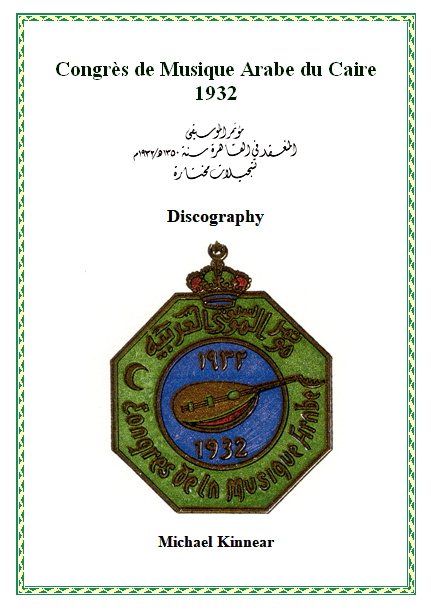 In 1932, a special congress of Arabic musicians was organised by the French musicologist Baron Rodolphe Erlanger with the co-operation of King Faud 1 of Egypt (b.1868 – r. 1917-1936).
In 1932, a special congress of Arabic musicians was organised by the French musicologist Baron Rodolphe Erlanger with the co-operation of King Faud 1 of Egypt (b.1868 – r. 1917-1936).
The first Cairo Congress of Arab Music inaugurated by King Faud 1 of Egypt was held under the title of Congrès du Caire at the National Academy of Music, 22 Malika Nazly Street (now Ramses Street), Cairo from the 28th March to the 3rd April 1932. This was preceded by meetings of the delegations and invited dignitaries held from the 14th to the 27th March 1932.
Congrès de Musique Arabe du Caire, 1932 – The Delegates
Delegation: Béla Bartók, Composer, Paul Hindemith, Composer, Alois Haba, Composer, Henri Raboud, Composer, Emile Vuillermos, Music Critic, Erich Moritz von Hornbostel, Musiciologist, Robert Lachmann, Musicologist, Curt Sachs, Musicologist, Egon Wellesz, Musicologist, Baron Carra de Vaux, Scholar, Father Xavier Collangattes, Scholar, Henry George Farmer, Scholar and Musicologist, Alexis Chottin, Scholar, Baron Rodolphe d’Erlanger, Musicologist, Ali AL-Darwish, Musician, Sami Chawa, Musician, Tawfiq al-Sabbagh, Musician, Muhammad Kamil al-Khulai, Safar Ali, Mustafa Rida Bey, Mohammed Abd el-Wahab, Mehmed Rauf Yekta, Massaud Cemil Bey Tel, Ahmed Shawqi, Poet, Raghib Muftah, Coptologist, Mohammed Kamil al-Hallaj, Ahmed al-Dik, Mahmoud Ahmed al-Hifni, Al-Arabi ben Sari, Algerian Delegation, Mohammed al-Kabbandji, Iraqi Delegation, Wadia Sabra, Lebanese Delegation, Umar Faid al-Junaydi, Moroccan Delegation, Ahmed al-Urabi, Syrian Delegation, Salim al-Hanifi, Syrian, Darwish al-Hariri, Egypt, Daoud Hossni, Egypt, Mohammed Najib, Egypt, Aziz Mohammed Uthman.
DISCOGRAPHY – Congrès de Musique Arabe du Caire, 1932
A compilation of the listings of matrix and catalogue numbers used by The Gramophone Co. Ltd. London has been derived from the recording ledgers so that the information provided in the listings are as accurate as can be ascertained.
A complete numerical catalogue, by matrix serials of the 78 rpm recordings from the Congrès de Musique Arabe du Caire 1932, taken at Cairo by the recording engineer George Walter Dillnutt (1883-1937), from the 15th March to 14th April, 1932.
George Walter Dillnutt made almost 350 recordings of musicians attending the Congress for The Gramophone Co. Ltd., Hayes, Middlesex, England and were released with special labels as a total of 162 records on the His Master’s Voice label, pressed at Hayes as non commercial recordings.
King Faud 1 made a gift of copies of these discs to the Musée de la Parole et du Geste in 1935 in recognition of their work, although a number of the (12-inch) discs did not form part of the original collection gifted to the Musée de la Parole et du Geste.
George Walter Dillnutt, Left
Figure 4.h Barrages; George Walter Dillnutt recording engineer from His Majesty’s Voice, Dr. H.G. Farmer, and M. ʿAwād (ʿud player from the Dhikr Laythī ensemble) (FC 503, 114).
Photo Courtesy: Henry George Farmer and the First International Congress of Arab Music (Cairo 1932), Page 187
Original Yellow Record Label Recorded 21st March,1932, Released November 1932,
Matrix No: OK-871-1, Catalogue No: 30-9629, Release Record No: HC 32
Delegation from Iraq, Mohamed el Kabbongi – Vocal, with Instrumental accompaniment. ‘Maly Aral Ham – 3’
Courtesy – Qatar Digital Library
A separate chronological listing of Mohamed el Kabbongi (the name used in The Gramophone Co. Ltd’s documentation) is at the end of this article. He is also referred to as Mohammed Al-Qubanji, Muhammad Al-Qubanchi and several other interpretations.
CONTENTS
Matrix Notes
1. Discography: Pages 1 – 20
2. Additional Recordings Alexandria, November 1935 and Baghdad, May 1939: Pages 21 to 22
3. Broken Records Damaged in Transit or Replacements: Page 23
4. Reissues: Pages 24 to 29
5. Concordance to Congrès de Musique Arabe du Caire, 1932, 18 CD Set by Bibliothèque Nationale de France, Abu Dhabi Tourism & Culture Authority: Pages 30 to 49
6. Chronological Listing of Mohamed el Kabbongi: Pages 50 to 53
DISCOGRAPHY
1 to 20
The matrix number is in the far left column (matrix prefix OK – 10″ and 2K – 12″ documented as assigned to George Dilnutt in 1931) and along side that is the catalogue or record number allocated to the matrix. C/w is coupled with another title as a double sided disc. The HC-1 Series is the record release number followed by the manufactured date.

1. Discography 10-inch HC-1 Series

2. Discography 10-inch HC-1 Series
LINK for the full article of 53 pages – The Cairo Congress of Arab Music – Discography
The Origin of the Name
The Gramophone Company, Limited’s factory at SEALDAH
The ‘bajakhana’ at Sealdah
‘The Gramophone Company’s First Indian Recordings 1899-1908’, Page 59
The name of this site originates from the local name given to The Gramophone Co., Ltd factory at Sealdah, nearby the Sealdah Railway Station, in those days, the main passenger and freight terminus, close to the business centre of Calcutta. Between 1902 and 1908, when the parent company in London operated in the name of The Gramophone and Typewriter, Limited, all pressings of ‘Gramophone’ disc records of Indian repertoire made by the company were manufactured at the Deutsche Grammophon, A.G., factory at Hanover, Germany. In January 1908, the name of company reverted back to its original title of The Gramophone Company, Limited, as did the branch in Calcutta.
In 1906, the board of directors in London considered the prospect of building a factory in India, with a site at Jubalpore in Central India being the first choice, however, with the lack of water and problems on acquiring the land being taken into consideration, a site near the Sealdah railway station was chosen, with building of the factory commencing in early 1907.
In July 1908 the manufacturing of disc records was started at the Sealdah factory located at 139 Beliaghata Road, Calcutta. Most of the labour force was drawn from the local community who referred to the factory as the ‘Baja-khana’ (as though it was a gymkhana of sound) and as the means of providing their livelihood, the workers inferred that they ate ‘sound’ for a living.
On 18 December 1908, the ‘official’ opening of the Sealdah factory was celebrated with an ‘at home’ function which featured a concert ‘in the tent’ by Miss Gauhar Jan of Calcutta, who was first recorded by The Gramophone & Typewriter, Ltd., on 11th November 1902, and over the next few years became the most celebrated artist that the company had on it’s roster of artists.
The Gramophone Co., Ltd. The ‘Official’ Factory Opening, Sealdah, 18 December, 1908
Michael Kinnear Collection
Within a few years the Sealdah factory was manufacturing discs and assembling machines, not only for India, Burma and Ceylon, but also the repertoires of the Dutch East Indies, The Malay States, Siam, and also Hong Kong and China. By 1921 the Sealdah factory had become very congested and was in need of an overhaul, and so in 1922 the power plant, engine-room and pressing plant were modernized to cope with the increased work-load.
In the ‘acoustic era’ up to 1926, the Sealdah factory was the busiest in Asia, and added a cabinet making house in 1926, on the open area in front of the tank, thus obscuring the original ‘majestic’ profile of the record factory and offices, which included recording rooms (on the first floor), from which emanated the many great recordings that kept the company profitable.
By the advent of ‘electric’ recordings in 1926-27, the Sealdah factory was in need of an extensive overhaul and the decision was taken by The Gramophone Co., Ltd., to build a new and up-to-date factory.
The Gramophone Company, Limited’s factory at DUM DUM

 The ‘bajakhana’ at Dum Dum
The ‘bajakhana’ at Dum Dum
‘The Michael Kinnear Collection’
In 1928, the Sealdah factory was closed and building work commenced at the new factory located at 33 Jessore Road, Dum Dum. The main building at the Dum Dum site had at one time been the infirmary of the Robert Clive Hospital, and was converted to the main offices of the company. The Dum Dum factory was equipped with the latest disc record pressing machinery and a separate facility for the manufacture of wooden cabinets for gramophones, and commenced operations in May 1929.
A new record pressing plant and other facilities were built on the site, including a separate building for recordings, which became known as the ‘Dum Dum Studios’. Although The Gramophone Co., Ltd., set up recording studios in Bombay, Delhi, Madras and other places, all pressing of the discs produced by the company, both for it’s own labels and several ‘private recording companies’ was done at the ‘HMV works’, Dum Dum.
Between 1932 and 1944, the associate companies Columbia Graphophone Co., Ltd., and Carl Lindström, A.G. Berlin operated as separate concerns with their own distribution set-up, however, by 1942, the “Odeon” label had been dropped and the administration of the “Columbia” affiliate merged with The Gramophone Co., Ltd.
For a few years before 1947, The Gramophone Co., Ltd., also had a small record factory at Chehharta, near Amritsar in the Punjab, which was known as the ‘Auxiliary works’. Up to 1946, The Gramophone Co., Ltd., in India was owned and controlled by the British parent company (Electric and Musical Industries, Ltd., from 1931) but was converted to an Indian company in 1947, in the name of The Gramophone Company of India, Ltd.
The decision to cease manufacture of 78-rpm records was taken in April 1969, however, 78-rpm records continued to be manufactured up to October 1970 at the Dum Dum factory, when the last entries were made to the catalogues, with many releases being available in alternate 78-rpm and 45-rpm versions, although micro-groove discs had been introduced in the late 1950’s.
The production of micro-groove recordings at Dum Dum was phased out in the mid 1980’s, in favor of the Cassette format, which has been the dominant format in India during the last couple of decades. During the 1980’s the controlling interest in the company was acquired by RPG Enterprises, in association with EMI, Ltd. The Dum Dum factory continues to produce and manufacture recordings to this day – thus celebrating over 75 years in the sound recording industry of India.
The National Gramophone Record Manufacturing
Co., Ltd, Wadala
‘The 78 rpm Record Labels of India’ – Michael Kinnear, Page 357
By mid-1927, The Viel-o-phone Co., Ltd., was producing and pressing disc records under a variety of labels, however, technical and financial problems had forced the closure of the Matunga factory by early 1933. The pressing of disc records by the Matunga factory had encouraged The Gramophone Co., Ltd., to organise a subsidiary company in the name of The Twin Record Co.,. Ltd., Calcutta, in competition with the Matunga factory, often replicating the same releases with releases on the ‘Twin’ label under pseudonyms.
Along with Valabhdas Runchordas, other entrepreneurs, including Chandi Charan Saha [Hindusthan Musical Products & Varieties, Syndicate, LTD., Calcutta], J. N. Ghosh [The Megaphone Company, Calcutta], and Bibhati Bhushan Sen [Senola Musical Products, Calcutta] were also keen to set up their own disc record pressing factories, but were persuaded by The Gramophone Co., Ltd., to have their disc records made by the Dum Dum factory, with releases being marketed by these companies from 1932-33 onwards.
 Although the Matunga factory had closed, Dulerai A. Pandya, an industrialist with interests in salt and manganese mining, and manager of the Mayurdhwaj Manganese Works at Dharangadhra, in Kathiawar District, was interested in setting up a record factory, and in May 1934, travelled to Japan where he acquired a disc record pressing plant and engaged Japanese technicians and a record engineer to set up his company.
Although the Matunga factory had closed, Dulerai A. Pandya, an industrialist with interests in salt and manganese mining, and manager of the Mayurdhwaj Manganese Works at Dharangadhra, in Kathiawar District, was interested in setting up a record factory, and in May 1934, travelled to Japan where he acquired a disc record pressing plant and engaged Japanese technicians and a record engineer to set up his company.
Dulerai A. Pandya, like Valabhdas Runchordas was a staunch Nationalist and supporter of the ‘Swadeshi’ movement for the Runchordas, and financial assistance from wealthy industrialists in the mining industry, in late 1934, Dulerai A. Pandya established The National Gramophone Record Manufacturing Company, Limited, with its head office at Jhaveri House, 110 Medows Street, Fort, Bombay, where other members of his family conducted a business as accountants and solicitors.
A factory was acquired at the ‘Old Laxmi Mill Compound’ Sewri Cross Road, Wadala, formerly used as a cotton mill, operated originally as the Welji Dharamsey Mill, then known as the Shree Laxmi Mills, operated by the Shree Laxmi Mills. Limited. By early 1935, Wadala factory was ready to commence operations, and recording sessions had taken place of several well-known artists, some of whom had previously made recordings for The Gramophone Co., Ltd.
The National Gramophone Record Mfg. Co. Ltd. – Advertisement.
Dulerai A. Pandya had strong connections with H.H. Ghanshyamsinghji Ajitsinghji, the Maharaja of Dhranghadhra State and the Indian National Congress party, and arranged for Pandit Jawahirlal Nehru to officiate at the opening and blessing of the Wadala factory, and who kindly made a couple of recordings for the ‘National’ company to encourage the development of indigenous industries. The ‘National’ company proudly advertised that made – 100% Swadeshi Gramophone Records’ of the latest process.
The National Gramophone Record Manufacturing Co., Ltd., launched its product under the “Young India” label, for which the trademark featured the Indian national flag. Although the various labels affiliated with The Gramophone Co., Ltd., had most of the ‘gramophone personalities’ under contract, the “Young India” label grew in strength and also took on custom pressing work for ‘private recorders’ and by 1936, had also contracted to release the songs from films produced by reputable film producers of Bombay.
In 1938, the Prabhat Film Company {originally established at Kolhapur in 1929, relocated to Poona in 1933} managed by V. Shantaram {Shantaram Rajaram Vankudre} formed an association with The National Gramophone Record Manufacturing Co., Ltd. The releases of film-songs on the “Young India – Prabhat” label proved immensely successful, and contributed greatly to the financial stability of The National Gramophone Record Manufacturing Co., Ltd., who then lured other major film production companies to have their product issued by the Wadala factory.
Although The National Gramophone Record Manufacturing Co., Ltd., had continued to expand and make a profit, with the outbreak of World War Two the Japanese technicians and engineers who had been employed by the Wadala factory were forced to return to Japan. By 1942 the lack of raw materials and a number of technical problems led to a decline in the quality of disc records being produced by the Wadala factory. V. Shantaram, left the Prabhat Film Company in 1942 and set up another film production company in the name of Rajkamal Kalamandir, Ltd., at Bombay, and in 1943, had his film-song hits issued under the “Young India – Rajkamal” label by the Wadala factory.
By the mid 1940’s most of the ‘private recorders’ in Bombay who had obtained their disc records from the Wadala factory had gone out of business, however, The National Gramophone Record Manufacturing Co., Ltd., found other clients in the Gulf States and Iran. During 1947 to the end of 1948, the “Young India” label featured releases of popular songs in several languages, along with numerous ‘Nationalist’ songs in celebration of India having gained its independence in August 1947.
When introduced in 1935, the pressings made by the Wadala factory were of the highest quality, with smooth and well polished surfaces. and although most of the pressings were made in the regular black ‘shellac’ composition, the factory also pressed discs in a brown composition which had exception wearing qualities. By late 1948, however, the quality of pressings made by the Wadala factory had fallen to a very poor standard.
Following the releases of December 1948, the company suffered a major blow with the defection of V. Shantaram who placed his pressing requirements with The Gramophone Co., Ltd. With the departure of V. Shantaram, The National Gramophone Record Manufacturing Co., Ltd., had lost its major client, and was reduced to occasional ‘custom pressing’ work. By 1953, the Wadala factory had become almost unworkable and was offered for sale.
In March 1953, the Wadala factory was sold to H.R. Betai, the proprietor of The Brittania Talking Machine Co., of Calcutta, Bombay, Madras and Rangoon. H.R. Betai had earlier acquired the Talking Picture Record Co., of Calcutta and Rangoon, and sold off its master recordings to The Gramophone Co., Ltd. Hoping to make better use of the Wadala factory, H.R. Betai offered the factory to The Gramophone Company of India, Ltd., but when they declined the offer, the Wadala factory essentially ceased to operate and after struggling on for a couple more years was closed down in 1956.
Further information about the various disc record factories in India, refer to the revised and expanded edition of The 78 rpm Record Labels of India, Michael Kinnear, 2016, ISBN 9780957735576
Sound Recording in India
a Brief History
The ‘talking machine’ must be one of the most productive inventions of the modern age – for it has not only given a great number of people around the world a great amount of pleasure in the listening to either cylinder recordings in the early days and later disc records, but has also provided a substantial number of people with a means of employment and endeavor in various aspects of the industry that ‘sound recording’ has provided.
India has been no exception to the phenomenal popularity of the sound recordings and has in fact been at the forefront of both technological changes and cultural changes as represented in sound recordings. During the 1890’s a handful of traders, in Bombay and Calcutta, had taken on the phonograph as a side line to their other merchandise, and by the early 1900’s some of these traders were offering ‘private’ cylinder recordings – by eminent singers and songstress – as an inducement to potential purchasers of whatever models of phonograph that were on sale.
These  recording were not commercially produced, but made on blanks supplied by the traders. Amongst these traders was an importer named Valabhdas Runchordas, of Bombay, who imported phonograph machines and blank cylinders, and became one of the first wholesalers of Edison, Columbia, and Pathé products. As far as is known the foundation of an indigenous sound recording industry in India begins with Hemendra Mohan Bose, who began to take cylinder recordings of some of his friends in Calcutta during 1900 or sometime soon afterwards. Before long H. Bose, in business as a perfumer, and with an interest in photograph and printing.
recording were not commercially produced, but made on blanks supplied by the traders. Amongst these traders was an importer named Valabhdas Runchordas, of Bombay, who imported phonograph machines and blank cylinders, and became one of the first wholesalers of Edison, Columbia, and Pathé products. As far as is known the foundation of an indigenous sound recording industry in India begins with Hemendra Mohan Bose, who began to take cylinder recordings of some of his friends in Calcutta during 1900 or sometime soon afterwards. Before long H. Bose, in business as a perfumer, and with an interest in photograph and printing.
To begin with these recordings were not considered for the general public, and were taken by H. Bose simply to preserve the voices and sounds of his friends for private use. Within a couple of years H. Bose came to be known as the ‘first Indian talking machine man’ and transformed his private interest in sound recordings into a commercial venture – which were marketed in the name of H. Bose’s Records (cylinders).
H. Bose’s Record – Pathe Phono-Cinema-Chine
H. Bose – The Talking Machine Hall, Calcutta
While H. Bose had been active in a private capacity, The Gramophone Company, Ltd, London, whose establishment in England dates back to 1898, and who by 1901, had been reformed in the name of The Gramophone and Typewriter, Ltd., and had set up a branch office in Calcutta. The Gramophone Company, had recorded some forty tiles of Indian repertoire in London during early 1899, which were issued as ‘E. Berliner’s Gramophone’ records, however, these recordings were most likely of little more than curiosity value.
The establishment of a branch office in India was soon followed by the arrival of Frederick William Gaisberg in Calcutta in November 1902 along with young George Dillnutt – to take recordings for The Gramophone & Typewriter, Ltd., as part of a Far Eastern recording expedition. Fred Gaisberg took some 550 recordings in Calcutta during November and December 1902, the commercially issued discs of which had reached the market in India by mid-1903. These early disc records were manufactured in Hanover, Germany, a practice that continued up until 1908, when The Gramophone Co., Ltd., established its own disc record manufacturing plant at Sealdah, an inner suburb of Calcutta.
Willian Conrad Gaisberg (centre), George Dillnut (right), Calcutta
“We Leave Calcutta” [1906]
Photo from: The Voice -The Romance of Recording by William C. Gaisberg – India -Article 1′ – (Courtesy: EMI Archive Trust)
As the public demand for sound recordings and talking machines grew – so did the providers. The most notable of the agents and wholesalers was Valabhdas Runchordas, who traded in COLUMBIA, EDISON and PATHÉ products from December 1902. Valabhdas Runchordas was to remain prominent in the sound recording industry for several decades and might have dominated the industry in India were it not for the dominance of The Gramophone Co., Ltd., who by sheer marketing force and extensive financial commitment succeeded in dominating the industry in India.
The Gramophone & Typewriter, Ltd., engaged upon other recording expeditions in India during 1904-05, led by William Sinkler Darby, assisted by Max Hampe, 1906-07, led by William Conrad Gaisberg, assisted by George Dillnutt, and again in 1908, led by George Dillnutt who was assisted in the early part of the expedition by Fred Gaisberg.
Theodor Heinrich Max Hampe, William Sinkler Dardy, Bombay, February 1905
‘The Gramophone Company’s First Indian Recordings 1899-1908’, Page 25
While this activity had been going on Nicole Frères, Ltd., London, had also undertaken a recording tour of India beginning in Calcutta during 1904 under the ‘recording expert’ Stephen Carl Porter. The issue of these recordings appeared in India as brown, celluloid-coated cardboard discs during 1905 as the NICOLE RECORD. At this stage both The Gramophone & Typewriter, Ltd., and Nicole Frères, Ltd.,in India were dependent upon disc record pressing facilities in Europe for supplies to India.
Nicole Record, Brown Celluloid Coated Cardboard Disc
In late 1905 there were rumors and reports of disc records being both recorded and manufactured in Bombay, and it seems that The James Manufacturing Coy. Bombay joined forces with a cycle trader named Rustomji Dorabji and had engaged a German recording expert to take the recordings – which were then manufactured on three hand presses in a rented room in Bombay by a business trading in the name of The Wellington Cycle Co., who marketed the discs through the Singer Phono and Record Agency as the SINGER RECORD, and also the JAMES OPERA RECORD through The James Manufacturing Coy.
The James Manufacturing Coy., Bombay
Singer Record, Plain Label, The Wellington Cycle Co.
During late 1905, Heinrich Bumb and Wilhelm Hadert took recordings for the Beka Record, G.m.b.H., Berlin, in both Bombay and Calcutta on behalf of Valabhdas Runchordas & Co.,, which were issued soon afterwards as BEKA RECORD (8″) and BEKA GRAND RECORD (10″) in 1906. To distribute the Beka products, Valabhdas Runchordas organized The Talking Machine and Indian Record Co., with offices in Bombay, Calcutta, Delhi and Madras.
T.S. Ramchunder, Rama-phone Record
During 1907, the Lyrophon-werke, Adolf Lieban & Co., of Hanover helped T. S. Ramchunder and Bros., Bombay, to place their RAMA-PHONE DISC RECORD (later changed to RAMA-GRAPH DISC RECORD) on the market, and the International Talking Machine Co.m.b.H. Berlin engaged an agent in India , who traded as The Talking Machine Co. of India, based in Calcutta, to assist in organizing a recording expedition in India – which soon afterwards were issued as the ODEON RECORD.
Apart from the JAMES OPERA RECORD and SINGER RECORD – all of the other makes were being pressed in Europe. In the meantime H. Bose had succeeded in recording and marketing cylinder records in Calcutta – with the assistance of Pathé Frères, Paris – and issued as H. BOSE’S RECORD’s (cylinders).
Soon after H. Bose entered the indigenous sound recording industry a couple of other firms by the names of Mukherjee & Mukharji of Calcutta who marketed the ROYAL RECORD and The Binapani Record Co. marketed the BINAPANI DISC RECORD. Both if these firms had a relatively short life-span as producers of sound recordings, but the competition offered by these firms had been a major factor which had compelled The Gramophone & Typewriter, Ltd., to establish its own factory in Calcutta by 1908, which gave the advantage of local manufacture, while all of the other major brands of disc records continued to be reliant upon their manufacturing facilities in Europe.
Mukherjee & Mukharji of Calcutta
This is a very rare example of the ROYAL RECORD
Permission by Amar Nath Sharma, Mumbai
An Advertisement for Royal Record, The Bengalee, 3 March, 1907
Miss Gauharjan and Noori
By 1908, H. Bose had conceded to technological problems and placed the transfer of his cylinder records to disc through Pathé Frères, Paris who reissued his cylinder recordings on disc manufactured at their factory at Forest, Belgium. Shortly afterwards, Pathé Phono Cinema Chine took over the Indian repertoire, including the H. Bose recordings, and organised further recording sessions in India, along with establishing branch offices in Calcutta and Bombay.
Between 1908 and 1912, The Gramophone Co., Ltd., went from strength to strength in the marketing of not only Indian repertoire but also in providing disc records for the whole Asian region. By 1912 most of the competitive makes had vanished from the market in India – with only the SUN DISC RECORD, marketed by F.B. Thanewala & Co., and the SINGER RECORD marketed by The Singer Phono & General Agency, both manufactured in Germany or England, appearing on the market in India.
The BEKA GRAND RECORD and the ODEON RECORD had achieved some success in India but the PATHÉ (disque) despite retaining H. Bose as their agent had failed to match the might of The Gramophone Co, Ltd. In 1912, a ban on German manufactured goods being imported into India, curtailed the supply of Beka and Odeon products.
To off-set any competition by 1910 The Gramophone Co., Ltd., had introduced the ZONOPHONE RECORD – as a cheap-priced rival to the SUN DISC RECORD, The ZONOPHONE RECORD at times imitated the exact couplings being marketed by BEKA GRAND RECORD, RAMA-GRAPH DISC RECORD, and the ODEON RECORD, amongst other makes. The introduction of the ZONOPHONE RECORD again displayed The Gramophone Co., Ltd’s ability to control the market in India.
By 1914, Valabhdas Lakhmidas & Co., (successors to Valabhdas Runchordas & Co.,) had remained the major competitor to The Gramophone Co., Ltd., to the extent that the company acquired machinery from German and Japanese sources and established The Viel-o-phone Co., Ltd., which succeeded for a short time in manufacturing discs from their small factory at Matunga, Bombay, with some assistance from J. E. Hough, Ltd., London. Valabhdas Runchordas also travelled to Germany hoping to acquire the master discs of his ‘Beka Record’ and ‘Odeon Record’ repertoires, however he only succeeded in acquiring the masters of the master discs of the SINGER RECORD – which were later reissued under the brand name of PHON-O-PHONE.
1916 saw the ‘official’ introduction of HIS MASTER’S VOICE record label to India – by which time The Gramophone Co. Ltd., had only The Viel-o-phone Co., Ltd., in Bombay to consider as a rival – as all the other European manufactured brands had vanished from the market – except the RAMA-GRAPH DISC RECORD of T. S. Ramchunder & Bros., Bombay, which continued to be manufactured in Germany by Carl Lindström, A.G. or one of its subsidiary pressing plants.
The World War between 1914-18 and reduced the sound recording industry in India to just two major operators: The Gramophone Co., Ltd., who had virtually created a monopoly to itself with just two labels – HIS MASTER’S VOICE and the ZONOPHONE RECORD, and Valabhdas Runchordas & Co., operating The Viel-o-phone Co., Ltd., with little more than reissues of the SINGER RECORD on PHON-0-PHONE RECORD and a very small repertoire of VIEL-O-PHONE RECORD issues, along with a few pressings from the English “WINNER” label of Edison Bell, Ltd., from the factory at Bombay.
Although The Pathephone Co., of Bombay, and T. S. Ramchunder & Bros., had remained active during the war years their output was very meager compared to both The Gramophone Co. Ltd., and The Veil-o-phone Co., Ltd., which had also virtually come to a standstill. By 1919 The Gramophone Co., Ltd., was the only active disc record manufacturer in India and virtually controlled the market. During the 1920’s The Gramophone Co., Ltd., continued to record hundreds of titles in various parts of India along with an extensive program of recording across the whole of Asia from Burma to China. In 1925, the ZONOPHONE RECORD was dropped and replaced by a green labeled HIS MASTER’S VOICE series.
In 1928, The Gramophone Co., Ltd., introduced the TWIN record label partly to exploit their past catalogue of recordings and also to saturate the market due to impending threats of the Columbia Graphophone Co., Ltd., and it’s associated company, Carl Lindström, A.G. and the ODEON record being marketed in India. There was also a renewed attempt by Valabhdas Runchordas to rejuvenate The Viel-o-phone Co., Ltd., – again with financial and technical support from Edison Bell, Ltd., London, which re-introduced the VIEL-O-PHONE label manufactured by the refurbished Mahim factory.
The manufacturing capacity of The Gramophone Co., Ltd., factory at Sealdah, Calcutta, had reached such dimensions that the plant was being operated twenty four hours a day in several shifts by 1926, and with this pressure it was decided to seek an alternative site and erect a new and larger factory to cater for The Gramophone Co., Ltd., requirements for the Indian and Asian markets. The new factory of The Gramophone Co., Ltd., was built at Dum Dum, some nine miles from central Calcutta, and commenced pressing in mid-1928.
By 1929 The Columbia Graphophone Co., Ltd., were actively recording in Ceylon, and soon commenced recording in Burma India and the Dutch East Indies. Carl Lindström, A.G. had also resumed recording sessions in Ceylon, Burma, and South India. At this point in time both the COLUMBIA and ODEON record labels were operated in competition with each other – and The Gramophone Co., Ltd., whose HIS MASTER’S VOICE and TWIN labels issued records – sometimes with identical coupling to those of its competitors.
Not having their own disc record factory in India, the COLUMBIA and ODEON labels were manufactured in London and Berlin respectively for the market in India and surrounding areas. Part of the strategy of the Columbia Graphophone Co., Ltd., and Carl Lindström, A.G., extending their activities into Asia, was due to strong competition from the Polyphon Musikwerke, A.G., of Berlin, who produced recordings of Chinese and Malay repertoires on the PAGODA and HINDENBURG labels for local distributors.
In 1930, Columbia Graphophone Co., Ltd., London, took over the Pathé Orient factory in Shanghai, China, hoping to develop this as a base for the South Asian market and take away some of the market share that The Gramophone Co., Ltd., had dominated for several years – sharing some of the territory with the Victor Talking Machine Co., Camden, USA. an associate company. The Shanghai factory operated as the China Record Company. Ltd., as manufacturers, and Pathé Orient, Ltd., as distributors, pressing BEKA, ODEON and PATHÉ (vertical cut) discs for the Chinese and Asian market.
In April 1931, Columbia Graphophone Co., Ltd., which included control of Carl Lindström, A.G. Berlin, [ODEON]; Compagnie Générale des Machines Parlantes, Pathé Frères, Paris, along with Pathé Orient; and The Nipponophone Co., Japan – representing COLUMBIA in that country – merged with The Gramophone Co., Ltd., worldwide. This merger formed Electric and Musical Industries, Ltd., (EMI, Ltd) into the largest sound recording company in the world, a corporate body representing not only it’s major amalgamated companies but also dozens of subsidiary concerns, agents and distributors internationally.
Despite the merger of ‘Columbia’ – ‘Gramophone’ – ‘Odeon’ and ‘Pathé’ interests and the control of these companies in India and Asia being under the ‘one roof’ the recording sessions operated by the various companies was expanded to such a level that each division of EMI, Ltd., was often questioning the activities of the other in both India and Asia.
The productivity of the recording engineers in these regions was somewhere in the region of 200 hundred recordings per two month period, with the effect that the HIS MASTER’S VOICE, TWIN, COLUMBIA and ODEON catalogues showed a rapid increase in releases.
Although financially controlled by Columbia Graphophone Co., Ltd., London, the Carl Lindström, A.G. of Berlin, had been independently established in India in 1929, through distributing agents, and in the early 1930’s, reorganized its activities in India by appointing the RUBY RECORD CO., of Bombay, and Saraswathi Stores, Madras, to handle their ODEON label, for which the manufacturing of discs shifted from Berlin to The Gramophone Co., Ltd., factory at Dum Dum.
Photograph taken during the Odeon recording sessions of December 1936.
Left to Right: R.D. Sethna (Ruby Record Co.), Shamsuddin Khan, Dashrath Mule, Balkrishna Kapileshwari, Harishankar Kapileshwari, Max Birckhahn (Recording Engineer), Seated: Abdul Karim Khan
‘Sangeet Ratna, The Jewel of Music, Khan Sahib Abdul Karim Khan – A Bio Discography’, Back Cover
Michael and Janine at the gravesite of Abdul Karim Khan and Banubi at Miraj, Southern Maharashtra
Ruby Record Co. Bombay, Record Catalogue, 1934
‘The Michael Kinnear Collection’
 Ruby Record Company, Fort, Bombay
Ruby Record Company, Fort, Bombay
Part Cardboard Odeon Records Promotion,
‘The Michael Kinnear Collection’
Ruby Record Company, Bombay, Abdul Karim Khan, Odeon Records Cardboard Promotion
The Michael Kinnear Collection
At the same time that this process was going on The Gramophone Co., Ltd., in India introduced a scheme of promoting what they termed ‘private recorders’ which meant that private companies were encouraged to access the recordings made by The Gramophone Co., Ltd., under contract, and have these recordings issued under their own labels, as if in competition to HIS MASTER’S VOICE, COLUMBIA, and ODEON.
The most important of these ‘private recorders’ were: The Megaphone Co., with the MEGAPHONE RECORD; the Hindusthan Musical Products, and Varieties Syndicate, with the – HINDUSTHAN RECORD and the NEW THEATRES RECORD; Senola Musical Products, with the SENOLA RECORD; all based in Calcutta, and The Talking Picture Record Company, originally established in Rangoon, Burma, but soon moved to Calcutta, with the SHAHENSHAHI RECORD, and DILRUBA RECORD. There was also Hutchin’s & Co., Madras, – HUTCHIN’S RECORD; who took their own recordings and Janki Nath Kumar & Bros., Lahore, – JIEN-O-PHONE RECORD.
N.B. Sen & Bros, Calcutta – Senola Records Catalogue
Within the space of a few years there were no less that forty ‘private recorders’ with their own labels being manufactured – under contract – by The Gramophone Co., Ltd., Dum Dum. apart from their own issues on HIS MASTER’S VOICE, TWIN, COLUMBIA and ODEON. Some of these ‘private recorders’ only managed a couple of batches of releases, before exiting the market, while others such as The Marwari Record Co., Jodhpur, and The Maxitone Record Co, Ltd., of Cawnpore, built up extensive catalogues of ‘regional’ repertoires.
Marwari Record Catalogue, 1934-1984
During the early 1930’s the ‘talkies’ had reached India and created a demand for songs on record which was to change the function of the sound recording industry in India, to the extent that the previously dominant classical and light music became virtually redundant within a couple of years amounting to just a few percentage of the company’s output. The songs from the films were what the buying public wanted on discs, and although the Dum Dum factory was working to capacity, the era was one of the most productive in the company’s history.
While The Gramophone Co., Ltd., enjoyed the success of its productivity resulting from the songs issued from the films of the rapidly expanding motion picture industry, the Columbia Graphophone Co., Ltd., – COLUMBIA RECORD, and Carl Lindstrom, AG. – ODEON – aggressively recorded in the areas of classical and regional music.
Following the example of the ODEON label, The Musical Products, Limited, Madras was formed in 1934 with financial backing on a large jewellery firm to record and promote the BROADCAST record in India. Offering large sums of money The Musical Products, Ltd. managed to lure some of the finest talents in India to its label, with the disc records were being manufactured by The Crystalate Gramophone Record Manufacturing Co., Ltd., Tonbridge, in England, but within a few years the BROADCAST label too failed to achieve profitability and closed.
The revitalization of the sound recording industry and particularly the success of the new popular medium of ‘film songs’ did of course not go un-noticed. In 1935, a promoter by the name of Dulerai Pandya found considerable financial backing to form The National Gramophone Record Manufacturing Co., Ltd., with offices in Bombay and a factory at Wadala in the northern suburbs of Bombay.
The rise of The National Gramophone Record Manufacturing Co., Ltd., and it’s label – YOUNG INDIA, was the most serious attempt to break the monopoly that The Gramophone Co., Ltd., had held for several decades, and it went far in signing up the Prabhat film company to its contract, along with engaging in a number of ‘private recorders’ – as had The Gramophone Co., Ltd., to extend it’s market share of products.
Thus the situation in India had changed from the sound recording industry being based in just two active labels in 1927 to over one hundred a decade later. Apart from the ‘Gramophone’ and ‘National’ manufacturing plants, a small firm by the name of Samudophone Co., set up in the Punjab attempting to break into the sound recording industry but failed to make any impression and soon folded. Also in the Punjab, at Chehharta, a small factory was set up by H.R. Singh & Co., but failed to go into production, and some years later the land and plant were bought by The Gramophone Co., Ltd., as an auxiliary factory.
Over in Shanghai the operations of the China Record Co., Ltd., and Pathé Orient, Ltd., had slowly eaten into the market that had formerly been the province of The Gramophone Co., Ltd. in Hong Kong, particularly as far as the Chinese and South East Asian repertoire were concerned. In 1934 the Shanghai businesses were renamed Electric and Musical Industries (China) Ltd., and continued to be run as a profitable concern for that region through to 1939. Although there was a certain degree of overlapping of supplies, The Gramophone Co., Ltd., remained dominant in Singapore and the Malay States, producing extensive catalogues of Chinese and Malay recordings which were issued on the CHAP SINGA (Lion) and CHAP KUTCHING (Cat) labels for local distributors, alongside their own ‘house’ brands.
The onset of World War Two found The Gramophone Co., Ltd., in all sorts of difficulties and disruption to its recording and disc pressing program which had been expanding on a very profitable basis. During the war years the Dum Dum factory had turned over much of its resources to providing items for the Government of India, and found several of its key personnel on War Service.
While the war continued The Gramophone Co., Ltd., had considered that it would be opportune to establish an auxiliary factory in case the Dum Dum factory became inoperative, and thus the small plant of H.R. Singh & Co., at Chehharta, near Amritsar was purchased, and after some teething problems went into production in 1943.
The effect of the war on the sound recording industry in India was direct in that it forced the closure of Carl Lindstrom, AG’s interests in India with the ODEON repertoire being transferred to the COLUMBIA label. The slump in sales during the war years also had a dramatic effect on The National Gramophone Record Manufacturing Co., Ltd., which had risen to being a strong competitor to The Gramophone Co., Ltd.
The ‘National’s, major resource had been the Prabhat Film Company, Poona, which had provided The National Gramophone Record Manufacturing Co., Ltd., with a large number of strong selling ‘film songs’ – but had shifted its allegiance to The Gramophone Co., Ltd., in about 1943. Thereafter The National Gramophone Co., Ltd., was highly reliant upon ‘custom pressing work particularly from The Bombay Record Co., Bombay and other ‘private recorders’ – some of whom also had contracts with The Gramophone Co., Ltd., for pressing work – under different labels. The National Gramophone Record Manufacturing Co., Ltd., also took on pressing work of ‘Persian’ repertoires on for Iranian clients, represented in Bombay by The United Iranian Co., with discs pressed under the YOUNG IRAN and NAYA-YE-IRAN labels.
By 1946 it was evident that India would become independent of the British Empire and that the country would be divided into India, West and East Pakistan. As the political maneuvering unfolded The Gramophone Co., Ltd., purchased the business of Janki Nath Kumar & Bros., Lahore, which had been highly successful, and also relinquished it’s offices in both Karachi and Lahore. The Gramophone Co., Ltd., also acquired the repertoires of The Frontier Trading Co., with the BANGA-PHONE RECORD, and the Bajaj & Co., with the GULSHAN record, whose businesses were located at Peshawar, in the North West Frontier Provinces.
The changed economic and political climate also caused The Gramophone Co., Ltd., to restructure its corporate interests in India into The Gramophone Co (India) Ltd., as an Indian company and also to close most of the ‘private recorder’ programs that it had been operating since the early 1930’s. While India was going through the motions of establishing its independence, the factory in Shanghai, which had been in the hands of the Japanese during the war years, had become somewhat dormant although not closed with the result that a certain amount of the manufacturing done by the Shanghai factory was returned to Dum Dum for servicing in the Asian region.
After a couple of years absence from Pakistan territories The Gramophone Co., Ltd., re-opened offices in Karachi and Dacca in 1950, but over the next three years was obliged to re-construct its operations in both East and West Pakistan into the formation of The Gramophone Company of Pakistan, Ltd., jointly organized by EMI, Ltd., London and Pakistani share-holders, eventually becoming EMI (Pakistan) Ltd.
During 1954, the Dum Dum factory was forced to close for several months due to disputes over worker conditions, and had to have some of its discs pressed by another company. Although The National Gramophone Record Manufacturing Co., Ltd., Bombay, was nominated to undertake the pressing work on behalf of The Gramophone Co., Ltd., its disc pressing factory at Wadala had become unfunctional, and was in drastic need of an overhaul. Doubtless The National Gramophone Record Manufacturing Co., Ltd., might have been glad to have the business as it had been gradually sliding into failure, and indeed survived only a couple of more years, eventually closing its offices and factory in 1956.
The Gramophone Co., Ltd., turned to The Plastic and Industrial Corporation, Bombay, who had a small factory at Worli, which produced ‘plastic’ records in limited quantities. For a short time the discs issued by The Gramophone Company of India, Ltd., were pressed by the ‘Plastic’ factory at Worli, which also produced the BULBUL label for Music Masters Ltd., Bombay.
The Plastic and Industrial Corporation, Bombay, holds the distinction of being the first company in India to manufacture micro-groove recordings in the long-play format, however, due to technical problems, the manufacture of vinyl and long-play discs did not last long and the company gave up its involvement with pressing disc records. During the phase of The Gramophone Company of India, Ltd labour dispute, the Dum Dum factory was re-fitted to produce micro-groove discs.
The Gramophone Company of India, Ltd., tended to rationalize its assets and resources during the 1950’s with the winding down of the ‘Columbia’ branch of its operation and also in curtailing the number of ‘private recorders’ that it supplied pressings for. The decade also brought in new technology by the introduction of the Long Play (33-1/3 rpm), Single Play and Extended Play discs (45 rpm), although the 78 rpm disc remained in production up until 1970.
The total number of 78 rpm discs recorded and issued by The Gramophone Co., Ltd., in India is estimated to be in the region of some 500,000 titles to which might be added some 30,000 recordings by the various competitor companies that had been operating in India over the past sixty odd years.
During the late 1960’s The Gramophone Company of India, Ltd. was challenged in the market for Indian repertoire by the formation of Polydor India, Ltd., who had a disc pressing plant at Kandivlee, north of Bombay. Thus developed a market struggle between the ‘Gramophone’ and ‘Polydor’ companies in India for the rights to songs from the films being produced by numerous motion picture producers in India. In recent years Polydor India, Ltd., has been reformed into Music India, Ltd., and remains a vital force in the sound recording industry in India.
Hindusthan Musical Products, Ltd., who had since 1933, been recording their own repertoire along with resources of The Gramophone Co., Ltd., formed The Indian Record Manufacturing Co., Ltd., in 1977 with a disc record factory at Taratalla Industrial Area, Calcutta, and pressed their own HINDUSTHAN RECORD and INRECO discs – that had previously been manufactured by The Gramophone Co., Ltd., at Dum Dum.
Perhaps the most significant development of the 1970’s was the introduction of the cassette, which had found most companies in India fettered by Government regulation in regard to the importation of machinery and tariff restrictions. While the matter were being sorted out ‘pirate’ cassette concerns in Singapore and Thailand were saturating the Indian and Asian market for sound recordings with ‘illegal’ copies of much of The Gramophone Company of India, Ltd repertoire.
Although the importation of ‘pirate’ cassettes was basically brought to a halt as far as India was concerned, the public demand for product of both old and new recordings was such that several cassette manufacturing concerns came into the market in India, again often producing ‘illegal’ copies of The Gramophone Company of India, Ltd, repertoire, or versions of the same film songs and ‘hits’ that The Gramophone Company of India, Ltd., and Music India, Ltd., had paid high royalty rates for access to.
Amongst the dozens of new cassette manufacturing companies, most of whom were engaged in quite legitimate marketing of their own products, there were a number of operators who had quite blatantly sought to damage The Gramophone Company of India, Ltd dominance of the market by marketing pirate copies of their product, and very nearly succeeded in forcing closure of the once almighty company.
The 1990’s have witnessed the rise of new sound recording companies such as MagnaSound (India), Ltd., Bombay; The Master Recording Co., Ltd., Madras; Concord, Ltd., Calcutta; CBS Gramophone Records and Tapes. Ltd., Bombay; Super Cassettes Industries, Ltd., Delhi, Music Today, Ltd., Delhi; The Venus Record Co. Ltd., and many others, all vying for their market share in the Indian sound recording industry.
The Gramophone Company of India, Ltd. {now known as Saregama, Ltd.}has without doubt lost much of the market to these numerous other sound recording companies, but it is still recognized as the market leader in India. It is estimated that during the 1990’s there have been well over one hundred companies set up to produce, manufacture and market cassettes in particular.
The international demand for Indian music has also led to a number of companies being formed in Europe, the United States of America, and other places, who have engaged upon their own recording programs, with such companies as Chhanda Dhara, Germany; Natraj Music, Germany: Audiorec, Ltd., England; Navras Records, England; Nimbus Records, England; Ali Akbar College of Music, (AACM), Raga Records, New York; India Archive Music, New York; Moment Records, Oriental Records, New York, and several others producing fine recordings aimed primarily at the growth in popularity of the compact disc.
Internationally the new medium for sound recordings – the compact disc has totally revitalized the world market, but at present the cassette remains the popular medium in India, and it has yet to be seen how the various sound recording companies in India will adapt to the compact disc and other technological improvements.
Reflecting upon some ninety years of sound recording in India, it is sad to see that the preservation of old recordings, has been very badly neglected, particularly in regard to the ‘non-film’ repertoire, perhaps the newer generations will take a more vital interest in the incredible wealth of musical heritage and culture that has been preserved on the old discs.
The Nicole Record
Nicole Record, L.C. Bural. C.175 and C.176
‘The Michael Kinnear Collection’
L.C. Bural
‘The Gramophone Company’s First Indian Recordings 1899-1908’, Page 60
Nicole Frères was established in 1815, as a musical box maker at Geneva, Switzerland. Over the next few decades the firm achieved a reputation for excellence in the quality of the machines. By 1880, the firm had opened a branch in London managed by Charles Brun, which, by October 1897 had acquired the assets of the Swiss business and was reformed as Nicole Frères, Limited, operating from 21 Ely Place, Holborn, London.
Nicole Frères, Limited began selling phonograph and talking machines, along with a variety of other musical boxes and automatic apparatus, including “Polyphon” and “Regina” machines, for which the company established selling agencies. By 1901, Nicole Frères, Limited had become selling agents for the International Zon-o-phone Company of Berlin, and by June 1902, had formed a subsidiary interest known as the New Record Account, which in essence was an attempt to set up a factory to manufacture disc records in association with the International Zon-o-phone Company, however, by June 1903, The Gramophone & Typewriter, Ltd., had acquired control of the International Zon-o-phone Company of Berlin, which brought an end to that proposal. In the meantime Nicole Frères, Ltd., set about reforming the subsidiary interest to produce their own disc records under a patent lodged by Carl Hugo Krieger and George Henry Burt.
In the interim, Nicole Frères, Ltd., had entered into negotiations with Gianni Bettini, to manufacture disc records for his company operating in France as Société des Micro-Phonographes Bettini. In May 1903, the directors of Société des Micro-Phonographes, Bettini, bought out the company, and reduced Gianni Bettini’s role to that of a Manager only, and re-organised the company in the name of Société des Phonographes, Bettini, however, following several months of negotiations, the proposed venture with Nicole Frères, Ltd., was abandoned, with Société des Phonographes, Bettini, later turning to The Crystalate Manufacturing Co., Ltd., Tonbridge, Kent, in which George Burt had an interest, to furnish their disc record pressings.
In July 1903, The Nicole Record Company, Limited was established with a disc record factory located at Great Saffron Hill, Holborn, London, to record and manufacture disc records which were constructed of a cardboard base coated with celluloid, under the patent of Krieger and Burt, and with the details of the recording printed directly to the disc face in silver paint.
Although The Nicole Record Company, Limited was the manufacturer of the disc records the marketing and distribution of the product was administered by Nicole Frères, Limited. Soon after the launch of the Nicole Record the company began to market its own models of talking machines under the name of ‘Nicolephone’ in a variety of models.
 The earliest ‘Nicole’ recordings of English and German repertoires were taken by Rudolf Eckhardt, followed by Stephen Carl Porter. In February 1904, John Watson Hawd, who had recently been the Calcutta Branch Manager of The Gramophone & Typewriter, Ltd., joined The Nicole Record Co., Ltd., and by late 1904 had journeyed to India with Stephen Carl Porter to make recordings in Calcutta.
The earliest ‘Nicole’ recordings of English and German repertoires were taken by Rudolf Eckhardt, followed by Stephen Carl Porter. In February 1904, John Watson Hawd, who had recently been the Calcutta Branch Manager of The Gramophone & Typewriter, Ltd., joined The Nicole Record Co., Ltd., and by late 1904 had journeyed to India with Stephen Carl Porter to make recordings in Calcutta.
Nicole Record, Steve Porter, 7″ No. 650, 9 3/4″ No. 5112
Michael Kinnear Collection
In May 1905, the South African branch of Nicole Frères, Limited had been converted into a separate company, and by September 1905, Thomas Clement Usher, the Chairman of Nicole Frères, Limited had acquired the Indian branch of the company and reformed it as a separate company in the name of Nicole Frères (India) Limited, with its head office in London.
In the meantime Arthur Henry Brooks had joined The Nicole Record Co., Ltd., as a recording expert and conducted recording sessions in London, Paris and Stockholm, followed by further recording sessions in London, which included Operatic selections made by performers associated with the San Carlo Opera Company, which were marketed as Nicole ‘Meister’ Record discs.
By mid 1905, Nicole Frères, Limited had built up an extensive catalogue of recordings in English, French, German, Italian and Swedish selections, and a large selection of Indian recordings in Hindustani, Bengali and Urdu. In October 1905, Nicole Frères, Limited had introduced the Double-sided Nicole ‘Duplex’ Record, which included a selection of older recordings along with new selections. By now the ‘Nicole Record’ was being issued with printed paper labels, to replace the older version of printing directly to the disc face., and by January 1906, had introduced their own gold-moulded ‘Champion’ cylinder recordings.
Although the marketing of the ‘Nicole Record’ appears to have been a success, by early 1906, Nicole Frères, Limited was facing a financial crisis and had failed to repay a series of debentures held by the company’s Chairman, Thomas Usher. In March 1906, Thomas Usher served a writ of summons against Nicole Frères, Limited, for failure to repay its debt to him, and called for the company to be wound-up.
In July 1906, Nicole Frères, Limited was placed into liquidation, and with this action, The Nicole Record Company, Limited was left without a distributing agency. While Nicole Frères, Limited was in the process of realising its assets, John Watson Hawd had moved to Stockport, near Manchester in the North of England, and had organised his own disc record manufacturing factory in the name of The Disc Record Company, Limited, and by September 1906 had acquired the machinery, plant and matrices of The Nicole Record Company, Limited.
Having acquired the ‘Nicole Record’ master recordings, by late 1906, The Disc Record Company, Limited, had begun to reissue the recordings under the original brand name with an emphasis on India where Nicole Frères (India) Limited continued to operate as a separate company, and also offer the recordings to a number of clients in England, with pressings made from the ‘Nicole’ masters under labels of the clients choosing.
In January 1907, The British Sonogram Co., Ltd., had been formed by Hans Knudsen and George Burt, and shortly afterwards marketed the “Sovereign Record” utilizing ‘Nicole’ master recordings. This company collapsed with a few months, however, John Watson Hawd continued to offer disc record pressings made from ‘Nicole’ masters to clients until well into 1909. By this time however, Nicole Frères (India) Limited had ceased to operate in India with the “Nicole Record” labelled discs of the celluloid coated-cardboard base type of disc finally being discontinued, although The Disc Record Company, Limited continued to use the ‘Nicole’ masters for ‘custom-pressing’ work on behalf of its clients in the hard composition {shellac} type of pressing, including re-pressings of Indian and Swedish recordings with the “Nicole Record” label.
In 1909 The Disc Record Company, Limited supplied pressings of the “Sun Disc Record” for F.B. Thanewalla, of Bombay, and then went into a period of inactivity due to court actions being taken due to the liquidations of The British Sonogram Co., Ltd., and an associate company named Hawd & Spicer, Ltd.. As these court cases progressed, The Disc Record Company, Ltd., then took up supplying pressings to ‘tallyman’ {hire-purchase} operators, including The Britannic Record Company, Ltd., London.
By 1912, The Disc Record Company, Ltd., had relocated its factory to Wealdstone, near Harrow, west of London, and continued disc record manufacturing work utilising ‘Nicole’ masters for its clients. In 1913, the “Pelican Record” was marketed through The Universal Record Syndicate, and then taken over by Blum and Co., London, which was destined to be the last use of the ‘Nicole’ master recordings. In June 1915, The Disc Record Company, Ltd., relocated its head office to Harrow, and the factory at Wealdstone was leased to W. H. Reynolds, Ltd., who then took over the factory which became known as the Reno Works in August 1915. Although W. H. Reynolds advertised a disc record under the brand name of “Defiance Record”, it would appear that the use of the ‘Nicole’ masters had ceased with the relocation of The Disc Record Company, Ltd., to Harrow.
Although the “Nicole Record” was only marketed for about five years in its own right, followed by re-pressings on a variety of labels for a few years more, none of the recordings have survived into modern times.
♦ ISBN-10: 0-6456719-2-4
♦ ISBN-13: 978-0-6456719-2-6
The Persian Page
A Brief History of the Sound recordings in Persia
The earliest known recordings of PERSIAN repertoire appear to be a series of recitations – recorded in London, England in early 1899. These early recordings were part of a series of some 45 ‘Oriental’ recordings taken by The Gramophone Company, London, and included recordings in Hindi, Urdu and Sikh (Gurmukhi) by virtually unknown persons. These early recordings which were issued as 7 inch – single-side recorded discs without labels – under the trade mark of “E. Berliner’s Gramophone” – but none have survived or been preserved to qualify the nature of these sides.
The next recordings of PERSIAN repertoire were taken by Franz and Max Hampe, the recording experts of The Gramophone & Typewriter, Ltd., at Teheran in early 1906.
Gramophone Concert Record, 1906, G.C. 2-11000, Muzaffaredin Shah
Muzaffaredin Shah
(His Imperial Majesty the Shah of Persia)
SA MAJESTÉ IMPÉRIALE MOUZAFEREDIN CHAH
1906 Gramophone Concert Record, G.C. 2-11000
968 16-1-06 – Speech (rejected)
969 16-1-06 2-11002 Speech
970 16-1-06 2-11000 Speech
971 16-1-06 2-11001 Speech
The Teheran recording sessions of 1906 produced some 225 titles in 7, 10 and 12 inch sizes – reproduced at Hanover, as single-side recorded discs – issued on the GRAMOPHONE RECORD – GRAMOPHONE CONCERT RECORD and GRAMOPHONE MONARCH RECORD labels.
Gramophone Concert Record, 1906, G.C.-4-12002
These recording sessions produced some fine sides of notable musicians of the time including – Agha Hossein Taziehkhan, Ghorban Khan, and a number instrumental selections by Mirza Ali Akbar Khan – Saftar Khan and others – and also the first attempts to record – sets of ‘Dastgah’ – in multiple disc sets. At the end of these recording sessions five recordings were taken of the voice of the Shah, Muzaffaru’din, which were originally pressed for private circulation only, but later made available for public sale.
In 1909 a troupe of about a dozen musicians were sent to London to provide yet further recordings of Persian repertoire, under the supervision of William Conrad Gaisberg. The troupe included several famous names of the time including Taher Zadeh, Gholi Khan and Agha Hossein – along with the instrumentalists – Akbar Khan (Flute), Bagher Khan (Kemantche), Habihollab Khan (Piano), Darviche Khan (Tar). The London recording sessions of 1909 produced over 300 sides – many of which were extremely popular and remained on the catalogues well into the 1940’s – having been reissued on the HIS MASTER’S VOICE label.
A Persian Concert Party in the City Road
From: Gramophone News, Vol. V1. No. 51, page 5. May 1909.
Gramophone dealers only
‘The Michael Kinnear Collection’
In 1911, Pathé Frères, of Paris, sent their recording expert, T. J. Theobald Noble to Russia, on an expedition that extended through to the Caucasia’s and onto the remote areas of Chinese Turkestan. The PATHÉ recording tour took over 900 hundred recordings in all languages and dialects of the region including a number of Persian recordings. The discs issued from the ‘PATHÉ’ recording tour were reproduced – as ‘vertical-cut’ discs – which played from the inside grooves to the outer rim. These ‘PATHE recordings are extremely rare – and although they may feature some of the finest musicians of the time – no catalogue of releases has been found to verify the content or nature of these recordings.
The next recording sessions by The Gramophone Co., Ltd, of Persian repertoire were undertaken by Edmund Pearce in 1913 at Teheran – as part of an extended recording tour which also covered the Caucasian and Transcaspian regions. The Teheran sessions of 1913 produced about 145 sides – of strictly Persian repertoire – to which might be added a number of Persian and Tartarian recordings taken at Baku and Tiflis.
Some of the noted artists of the 1913 sessions include – Eftekhar Khanoum, Amdjad Khanoum, Zari Khanoum, and Mohamed Khan and Mechedi Rouhollab and Djenabe Demavendi – along with Hossein Khan (Kemantche) and Mirza Assadollah Khan (Tar) and other instrumentalists. The recordings issued from the 1913 sessions were manufactured at Riga (Russia) as ‘AMOUR – Gramophone Record’ discs, and later pressed at Calcutta (India) – and yet later reissued as ‘HMV’ pressings from Hayes (England) in the 1920’s.
The Gramophone Co., Ltd., Tiflis
Proprietor: The Gramophone Co., Ltd., London.
Branch The Gramophone Co., Ltd., 9 Golovinsky Prospect, Tiflis.
Manufacturer: The Gramophone Co., Ltd., Riga
The Gramophone Co., Ltd., Sealdah
Series: Numerical (Brown) [GRAMOPHONE]
Transfers to: AX- series His Master’s Voice {Pressed at Hayes}
Strictly speaking the ‘Amour Gramophone Record’ label contained no Indian repertoire nor was the label generally marketed in India. The label was used for the company’s Russian repertoire, and pressed at the Riga factory.
The Persian repertoire recorded by the company at Teheran in October 1912, was pressed during 1913 by the Riga factory using the brown “Amour Gramophone Record” label for distribution by the Tiflis branch. During mid-1915, with the German army threatening to over-run the town, The Gramophone Co., Ltd., abandoned the Riga factory and relocated the presses and masters to Petrograd, and then to Moscow.
The stampers and printed label stocks for the Persian and Caucasian repertoires were transferred to Calcutta, and repressed at the Sealdah factory during 1916, utilizing the original label stocks. Pressings of the “Amour Gramophone Record” were marketed in India, and also exported to Persia.
The shells and stampers of these selections were transferred from Sealdah to the Hayes factory in 1925, and reissued on the “His Master’s Voice” label in the AX- (10-inch) series which commenced in March 1925.
Apart from The Gramophone Co., Ltd., there have been reports that The International Talking Machine Co.m.b.H., Berlin, had also taken some recordings of Persian repertoire – but to date very little information has been found to confirm – what might have been issued on the ODEON RECORD label at the time. There may also have been other sound recording companies who had taken recordings of Persian repertoire – but it appears that The Gramophone Co., Ltd., was the major participant in this field at the time. Between 1915 and 1925 – there does not appear to have been any sound recording company active in Persia.
By the late 1920’s the interest in Persian repertoire had been rekindled by recording sessions undertaken by Polyphon Musikwerke, A.G., Berlin, and the Baidaphon Company of Cairo and Beyrouth. Both POLYPHON and BAIDAPHON had taken advantage of the situation The Gramophone Co., Ltd., had been inactive in the field of Persian repertoire for some years and opened branches and agencies in Teheran and other places in Persia.
Details of the POLYPHON and BAIDAPHON recordings have been found – and copies of the recordings issued by these companies are only found today among the most serious record collectors in Iran. The renewed interest in Persian repertoire also brought the Carl Lindström, A.G. [ODEON] back into the region – but with an emphasis on Iraqi recordings. With other competitors active in Persian repertoire – The Gramophone Co., Ltd., resumed its recording sessions in Persia, undertaken by recording experts based in India – but with the pressing of discs maintained in England.
Some of the important artists of the time were Qamar El Mou1ouk, Mortaza Khan (Tar), Selim Khan, Moulouk Khanoum, Iran Khanoum, Yehia Khan (Tar), Akhtar Khanoum and Madam Paraveneb. There may be several historically important recordings – particularly on the POLYPHON and BAIDAPHON labels of noted musicians and vocalists of the era – but the lack of information about these recordings – it is not possible at present to qualify either the artistic merit or technical value of the recordings.
By 1930, the variety of Persian recordings available had been enhanced by several hundred sides and also been added to recording sessions at Teheran by the Columbia Graphophone Co., Ltd., London. Some of the important artists to appear on the catalogues of The Gramophone Co., Ltd., at the time were Badii Zadeh, Koly Khan, Golrize Khanoum, Asghar Khan, and Mehr Afagh Khanoum, Abid Khonsary and Ikbal Ka Sultane (Abol Hassan Khan).
Badi Zadeh, Persian Recording Artist
1930 Catalogue, The Gramophone Co., Ltd.
During the early 1930’s The recording activities of The Gramophone Co., Ltd., and the Columbia Gramophone Co., Ltd., had come to dominate the recording of Persian repertoire – and although these two companies appear to have been in competition with each other they were in fact sister companies – having been merged into the multinational conglomerate – known at Electric and Musical Industries, Ltd., (EMI) in 1931.
Although the record labels of – HIS MASTER’S VOICE – COLUMBIA – ODEON – BAIDAPHON – and PATHÉ – were operated as separate concerns – they were all in essence – operations of EMI, Ltd., and as such represented a virtual monopoly in regard to Persian repertoire. However most of the important recordings that had been on the catalogues over the past three decades had been deleted, and despite the fact that new recording sessions were undertaken – the availability of Persian repertoire had fallen off by 1940 to a situation that had prevailed at the beginning of the 1920’s.
Between the mid 1920’s and up to the mid 1930’s the recordings of Persian repertoire by The Gramophone Co., Ltd., [HMV] were undertaken by the recording engineers of the Indian branch of the company – although the actual manufacturing of the discs was done at Hayes in England. During this period the territory was also divided up into more specific zones to provide repertoires of – Bahraini – Iraqi – Kowaiti – Kurdish – and Armenian – selections, which in former times might have been included in the ‘Eastern’ catalogues, but continued to be manufactured at Hayes.
In 1937, the popular vocalist Badii Zadeh, who made several recordings for The Gramophone Co., Ltd., over the past few years, travelled to Berlin where he made some 50 recordings for the Carl Lindstrom, A.G. company intended for release on the ODEON label and were later released for the Iranian market the navy blue A-243500 series.
During the period from 1937 to 1945, The Gramophone Co., Ltd., had remained the major sound recording company active in Iran, however, from the mid-1940′ 5 a large number of recordings of Persian repertoire were taken in India – by the United Iranian Co., Ltd., in association with The National Gramophone Record Manufacturing Co., Ltd., Bombay – and issued under the YOUNG IRAN and NAYE-YE-IRAN labels – featuring important recordings by Badii Zadeh and Madam Delkash amongst others.
In 1946 a proposal was put forward to join the various agencies in Iran that controlled the HIS MASTER’S VOICE – COLUMBIA and ODEON labels into one distributing organization. The agent for HIS MASTER’S VOICE declined to join such a group, however, the representatives for COLUMBIA and ODEON joined forces and merged into a single company by the name of The Iran Voice Co., Ltd. (Sherkat Sowt Iran, Ltd.) through which the Columbia and Odeon products were marketed.
The Iran Voice Co., Ltd., had been formed partly to rival the competition offered by the YOUNG IRAN and NAYA-YE-IRAN labels being manufactured by The National Gramophone Record Manufacturing Co., Ltd., of Bombay, with its factory at Wadala, in the northern suburbs of Bombay. In Iran N. Esheghi and Co., of Teheran and Shiraz, set up a record company soon after to market the MUSICAL RECORD.
By the early 1950’s it is estimated that some 4,000 recordings of Persian repertoire had been taken and issued on 78-rpm discs over the past five decades by the various record companies trading in the region. Although the number of recordings taken and issued may be enhanced by further research and findings, in the main the figure of 4,000 titles could be considered to be fairly close to the maximum number of commercial recordings placed on the market.
Taken in perspective the estimate of recordings of Persian repertoire could also be greatly enhanced by adding the very considerable number of recordings of affiliated repertoire taken in the Central Asian area north of Iran and the Caucasian and Transcaspian regions – and also those recordings taken of Afghani music and a sizeable number of recordings taken in India of Persian repertoire
It will be noted that although the actual recording of Persian repertoire was undertaken and controlled by ‘foreign’ companies – the organization of the recording sessions and the marketing of the discs issued to the public was the concern of local merchants. Up to the early 1950’s there does not appear to have been any indigenous manufacturer of Persian or Iranian discs in the 78-rpm format.
The Iran Voice Co., Ltd., (Sherkat-i-Sowt Iran, Ltd), established in 1947, seems to have been the first cohesive organisation to attempt to set up any indigenous Iranian record producing company, followed by the establishment of ‘Musical Record’ (Musikal, Sherkat-i-Taulidi, Shiraz and Tabriz).
During the early 1950’s recording of Persian repertoire almost came to a standstill, apart from the activities of the local record companies. The close of the 78-rpm era in the late 1950’s brought radical changes to the Iranian record market, basically due to the fact that there were no local disc record manufacturing facilities for the format. The international change of format to 45-rpm and 33-1/3 rpm (LP), brought with it renewed vitality to the recording of Persian repertoire. A number of new local record labels appeared, including Ahang-e-Ruz, Golden Record, Monogram, Royal, Tip-Top, and others.
Outside of Iran, the availability of Persian repertoire in international markets has been very slight indeed, although in recent times a large number of cassettes have been issued – both from Iran and also in the United States and England – restoring many interesting recordings of the 1930’s and 40’s of popular, folk and classical repertoire to the catalogues.
Between the 1950’s and 1980’s – there were little more than about 20 Long Play discs issued by international companies of Persian repertoire, in the main – all Classical or folk recordings, however the large variety of product marketed in Iran seems to have little exposure outside of the domestic market. During the same time frame the musical cultures of the Middle East in general and that of India have achieved considerable exposure in the International market. The lack of exposure of ‘Persian’ repertoire may also be attributed in some aspects to the political events taking place during this time in Iran itself.
The Iranian company – Ahang-e-Ruz had taken a number of fine recordings of Classical Persian music, several of which have now been made available in Compact Disc format (Caltex) – along with other more recent recordings. The variety of Persian repertoire available on cassette is now quite extensive – particularly in regard to popular and ‘film’ songs – and although ‘traditional’ music is well represented, there still remains a large selection of ‘historical’ and important recordings taken over the past ninety years that has yet to be restored to the catalogues – either by the ‘original’ recording companies – such as EMI, or by ‘licensed’ reissues through other labels.
In recent times, the French record companies – Ocora, Harmonia Mundi, Media-7 and Auvidis/Ethnic have issued some fine recordings of traditional Persian music, to which might be added occasional issues by King (Japan) and a few other small International companies.
The international acceptance of the ‘compact disc’ has challenged the cassette format in most recent times although cassettes have been the dominant format among the specialist producers of Irani music. Of the specialist companies providing both cassettes and compact discs to the market, Caltex Records, Kereshmeh Records, Taraneh Enterprises, Pars Video, all based in the United States, and the Iran based – Shahram and Art House labels, have presented a strong and varied selection of titles, catering not only for the Iranian community but also to the international audience.
The Zon-o-phone Record
The Zon-o-phone Trademark
The “Zon-o-phone” talking machine was introduced in 1898, originally as an “Improved Gramophone” built by the Universal Talking Machine Company. By 1899, the company had begun to produced ‘etched-face’ discs, distributed by the National Gramophone Corporation. Exports of these talking machines were handled by Frederick Marion Prescott, who engaged agents in Europe to the market the “Zon-o-phone” products.
In March 1901, Frederick Prescott organized the International Zonophone Company, in New York, and then traveled to Berlin where he set up the European offices of the company.
Between 1901 and June 1903, the International Zonophone Company produced about 6000 recordings in association with several agents including the Anglo-Italian Commerce Company of Milan, Ch. & J. Ullmann of Paris and London, along with agents in Russia, Germany, Austria, Spain and South America.
The Brazilian agent Casa Edison was the first enterprise to introduce commercial supplies of a double-sided disc record. In September 1901, the American distributing agency National Gramophone Corporation was declared bankrupt, and soon after reformed as the Universal Talking Machine Manufacturing Company, which held a substantial interest in the manufacturing of “Zonophone” products, including the European operations.
The International Zonophone Company offered strong competition to The Gramophone & Typewriter, Ltd; Columbia Phonograph Company; and the Victor Talking Machine Company. Concerned with the International Zonophone Company’s success, The Gramophone & Typewriter, Ltd., purchased the controlling interest in the company through its German affiliate Deutsche Grammophon, A.G. Berlin, acquiring control of the Universal Talking Machine Manufacturing Company, which was sold off to the Victor Talking Machine Company.
The Gramophone & Typewriter, Ltd., continued to market the original European “Zonophone” recordings for a couple of years, gradually replacing the original recordings and augmenting the ‘Zonophone’ catalogues with its own recordings, marketed as a cheaper priced label to its “Gramophone” products. Similarly the American ‘Zonophone’ catalogue was marketed under the auspices of the Victor Talking Machine Company until 1912, at which time the label disappeared from the American market.
The Gramophone Company, Limited continued to market the “Zonophone Record” in several countries through to the early 1930’s. The early recordings produced by the independent International Zonophone Company, between 1899 and 1903, include numerous selections of artistic and historical interest, which are most sought after by record collectors.
A few months later, the first Indian “Zonophone Record” labelled discs were manufactured and marketed by The Gramophone Co., Ltd., Calcutta, with catalogue numbers allocated to the X3-100000 numerical block series. The German pressings were renumbered to the Indian catalogue, by December 1910.
 Although the “Zon-o-phone Record” was amongst the first entrants in the disc record field, up until now there has not been any significant discographic study on the brand. Ernie Bayly, the former editor of ‘The Hillandale News’ and editor and publisher of ‘The Talking Machine Review, International’ – both well-respected journals in the field of record research, and Michael Kinnear collaborated to publish a discography of the “Zon-o-phone Record”.
Although the “Zon-o-phone Record” was amongst the first entrants in the disc record field, up until now there has not been any significant discographic study on the brand. Ernie Bayly, the former editor of ‘The Hillandale News’ and editor and publisher of ‘The Talking Machine Review, International’ – both well-respected journals in the field of record research, and Michael Kinnear collaborated to publish a discography of the “Zon-o-phone Record”.
This discography focuses on the output of the International Zonophone Company’s products between 1901 and 1903, and includes numerical listing of known recordings issued before and after the company was absorbed by The Gramophone & Typewriter, Ltd., in 1903.
This discography is the result of almost three decades of collating information and research on the label with the cooperation of EMI Archives, London and Frank Andrews, who is well-known to record researchers and collectors for his pioneering work in the field. Frank Andrews and Ernie Bayly have compiled another discography on the British releases under the title of ‘Zonophone Single-Faced Records’ published by the City of London Phonograph and Gramophone Society, Ltd., London. 1999.
The discography also includes a concise history of the International Zonophone Company’s formation and activities, and also information about recordings transferred or reissued under alternate pressings or other labels. While the discography lists known recordings issued in both Europe, North and South America, there are gaps in the numbering sequence which have not been found. Some of these numbers may not have been used, while others may be of obscure repertoires, which have yet to be verified, or issued under labels which do not appear to be relevant.
CD’s Produced from a Special Recording Project
As consultant to and Project Supervisor of Indian Historical Recordings Project on behalf of The Gramophone Co. of India Ltd., Dum Dum, officiated at EMI Music Archives, Hayes. Transferring original Indian 78 rpm shellac records from the early 1900’s to Digital Audio Tape format. The CD series was released as the “CHAIRMAN’S CHOICE’ in 1994.
Michael Kinnear on a Special Recording Project, EMI Music Archive, Hayes
CHAIRMAN’S CHOICE Great Gharanas Imdadkhani
Includes Ustad Imdad Khan – Sitar (9 selections – Recorded 1905, 1910)
Double Compact Disc .EMI 2CD CMC-1-82507-08 UK 1994
Double Cassette .HMV CMC 882507-08 India 1994
CHAIRMAN’S CHOICE Great Gharanas Patiala
Includes Ustad Kale Khan – Vocal (5 selections – Recorded 1904)
Double Compact Disc .EMI 2CD CMC-1-82513-14 UK 1994
Double Cassette .HMV CMC 882513-14 India 1994
CHAIRMAN’S CHOICE Great Memories Gauhar Jan / Malka Jan
Gauhar Jan [Disc On] (18 selections – Recorded 1902, 1904, 1905)
Malka Jan[Disc Two] (18 selections – Recorded 1907, 1909)
Double Compact Disc .EMI 2CD CMC-1-82517-18 UK 1994
Double Cassette .HMV CMC 882517-18 India 1994
CHAIRMAN’S CHOICE Great Memories, Abdul Karim Khan / Mohd. Bandi / Achhan Bai
Abdul Karim Khan – Vocal [Disc One] (23 selections – Recorded 1905)
Mohd. Bandi – Vocal [Disc Two] (8 selections – Recorded 1907, 1909)
Achhan Bai– Vocal [Disc Two] (9 selections – Recorded 1908, 1910)
Double Compact Disc .EMI 2CD CMC-1-82519-20 UK 1994
Double Cassette .HMV CMC 882519-20 India 1994
CHAIRMAN’S CHOICE Great Memories Peara Saheb / Ustad Mojooddin Khan
Peara Saheb – Vocal [DiscOne] (18 selections – Recorded 1904, 1906)
Ustad Mojooddin Khan – Vocal [Disc Two] (18 selections – Recorded 1904, 1908)
Double Compact Disc .EMI 2CD CMC-1-82521-22 UK 1994
Double Cassette .HMV CMC 882521-22 India 1994
CHAIRMAN’S CHOICE Great Memories Zohra Bai / Janki Bai
Zohra Bai – Vocal [Disc One] (18 selections – Recorded 1909)
Janki Bai– Vocal [Disc Two] (16 selections – Recorded 1907, 1908, 1909)
Double Compact Disc .EMI 2CD CMC-1-82523-24 UK 1994
Double Cassette .HMV CMC 882523-24 India 1994
INAYAT KHAN The Complete Recordings of 1909 (2 CD with booklet) *
Inayat Khan R. Pathan – Vocal (31 selections – Recorded 1909)
Double Compact Disc .EMI 2CD CMC-1050129-30 UK 1994
Double Cassette .HMV STCS-02B-850359 UK 1994
*Marketed by Uitgeverji Panta Rhei, Katwijk, Netherlands.
Publications by Michael Kinnear
View the PUBLICATIONS Page for full availability of Titles
The 78 rpm Record Labels of India
Author: Michael Kinnear
Revised and Expanded Edition – FULL COLOUR
Profusely Illustrated
An encyclopaedia of the 78 rpm record labels produced in India and elsewhere, covering all known record labels and histories of the producing concerns from 1899 through to the late 1960’s. With a Supplement on the numerical series of the major labels and an Appendix on the record labels of non-Indian and Asian repertoires made in or associated with India. With examples of most record labels (in full colour or black and white if no colour examples available). Bibliographical references and Index.
Product Details
♦Published Independently: Bajakhana – Michael Kinnear, Second Edition 1st March,2016
♦ Language: English
♦ Pages: 20+500, Perfect Bound
♦ ISBN-10: 0-9577355-7-X
♦ ISBN-13: 978-0-9577355-7-6
PRICE: AUD $130.00, plus postage.
2017 ARSC Award for Excellence in Best Historical Research in Record Labels
Best Discography
The Gramophone Company’s First Indian Recordings, 1899 to 1907
Author: Michael Kinnear
Revised, Corrected and Expanded Edition with a Lacuna of the first known disc recordings of Tibetan performers
First Published 1994 as: The Gramophone Company’s First Indian Recordings 1899-1907. Revised, Corrected and Expanded Edition with a Lacuna of the first known disc recordings of Tibetan performers. The Gramophone Company’s First Indian Recordings 1899 to 1907, is a discographical study of Indian recordings taken in London in 1899 for E. Berliner’s Gramophone, and at various places in India between 1902 and 1907, detailing all the known or traced recordings of several dialects and musical styles together with a study of the history and development of the sound recording industry in India. This newly revised study contains numerous additions and corrections, in particular, to the variety of alternate pressings made of these recordings. With an appendix and indices. With illustrations in the text.
Product Details
♦ Published Independently: Bajakhana – Michael Kinnear, Second Edition
10th March, 2016
♦ Language: English
♦ Pages: 28+374, Perfect Bound
♦ ISBN-10: 0-9577355-6-1
♦ ISBN-13: 978-0-9577355-6-9
PRICE: AUD $ 75.00, plus postage.
2020 ARSC Award for Excellence in Best Historical Research on Record Labels and General Recording Topics
Best Discography
The Gramophone Company’s Persian Recordings, 1899 to 1934
Author: Michael Kinnear
Revised, Corrected and Expanded, 2nd Edition
A discography of recordings taken in Persia by The Gramophone Company and its successor concerns, from 1899 to 1934. With a history of the activities of various recording companies who operated in Persia and the sessions conducted at Teheran and London of Persian repertoire.
With a supplementary discography of Persian recordings taken by the Columbia Graphophone Co., Ltd., between 1928 and 1934. Between 1935 and 1947, there were no recording sessions undertaken in Iran by Electric and Musical Industries, Limited, or its associate companies. However, in 1947, the company arranged for some six hundred recordings to be taken under the auspices of Sherkat Sowt Iran, Limited, of Teheran. Approximately two hundred recordings were produced equally for the ‘His Master’s Voice’ – ‘Columbia’ and ‘Odeon’ labels. The discographic documentation for the ‘His Master’s Voice and ‘Columbia’ labels have now been included in the Supplement section of this volume.
With appendices on numbering blocks and matrix serials. With illustrations in the text.
Product Details
♦ Published Independently: Bajakhana, 2nd Edition, 20-8-2019
♦ Language: English
♦ Pages: 16 +219. Perfect Bound.
♦ ISBN-10: 0-9577355-8-8
♦ ISBN-13: 978-0-9577355-8-3
PRICE: AUD $75.00, plus postage
The Gramophone Company’s Indian Recordings, 1908 to 1910
Author: Michael Kinnear
Digital Download Book
A complete numerical catalogue, by matrix serials, of Indian Gramophone recordings made from 1908 to 1910, detailing all known and traced recordings by The Gramophone Company, Ltd., in India. The second volume in the series of discographical studies on the recordings taken in India and released by The Gramophone Company, Ltd., between 1908 and 1910. With a detailed historical examination of the development of the sound recording industry in India up to 1914. With numerous illustrations in the text and appendices on numbering blocks and matrix serials.
Product Details
♦ Published Independently: Michael Kinnear – Bajakhana
♦ Language: English
♦ Pages: 20+364
♦ Digital Download Book – Published June, 2021
♦ ISBN-10: 0-6456719-0-8
♦ ISBN-13: 978-0-6456719-0-2
PRICE: AUD $25.00
NICOLE RECORD
A Discography of the Nicole Record & History
Author: Michael Kinnear
Digital Download Book
A discography of the ‘Nicole Record’. With a history of Nicole Frères, Limited, and The Nicole Record Company, Limited, and associated companies. (A numerical listing of all known recordings produced by The Nicole Record Company, Limited, from 1903 to 1906. Together with information about reissued and transferred recordings.) With Bibliography and indices and with illustrations in the text.
Product Details
♦ Published Independently: Michael Kinnear – Bajakhana
♦ Language: English
♦ Pages: 20+288 pages,
♦ Digital Download Book: Published 20th June, 2021
♦ ISBN-10: 0-6456719-2-4
♦ ISBN-13: 978-0-6456719-2-6
PRICE: AUD $25.00
The Zon-o-phone Record
A discography of recordings produced by the International Zonophone Company and associated companies in Europe and the Americas, 1901 -1903
Ernie Bayly (Author) and Michael Kinnear (Author)
Digital Download Book
A Discography of recordings produced by the International Zonophone Company, and associated concerns in Europe and the Americas from 1901-1903. With a history of the company’s international activities, and a Supplement on reissues and transferred recordings. With Bibliography and indices. With illustrations in the text.
Product Details
♦ Published Independently: Michael S. Kinnear18 + 494 pages
♦ Language: English
♦ Pages: 18 + 494
♦ Digital Download Book: Published 22nd June, 2021
♦ ISBN-10: 0-6456719-1-6
♦ ISBN-13: 978-0-6456719-1-9
PRICE: AUD $25.00
Sangeet Ratna, The Jewel of Music
Khan Sahib Abdul Karim Khan, A Bio-Discography (PDF Format)
Author: Michael Kinnear
Digital Download Book
22 Digital Audio Recordings, MP3
A 90-minute collection of ODEON Out-takes and Test Pressings
The 2nd Digital Edition, published in August 2022, ISBN-13: 978-0-9577355-9-0. (The ‘First Edition’ published in 2003 – Black and White Perfect Bound, 14+290 pages – ISBN-13: 9780957735552) is a revised and expanded Biography and Discography of Khan Sahib Abdul Karim Khan (1872-1937), 12+346 pages. With over 300 rare, mainly black and white, colour, sepia photographs, record labels, publicity brochures, most previously unpublished. The discography details all Abdul Karim Khan’s recordings from the 1905 sessions for The Gramophone & Typewriter, Ltd., and the 1934–1936 sessions for the ‘Odeon’ label, through the Ruby Record Co. Bombay. With details of un-issued recordings, out-takes, and reissues and numerous illustrations and label examples. This edition also includes Supplement Two with the four ‘Notation Books’ published by Abdul Karim Khan in 1911 and 1912 and Supplement Three with additional Concert Programs.
22 Digital Audio Recordings – A 90-minute collection of ODEON Out-takes and Test Pressings
Included with the 2nd Digital Edition are 22 – MP3 digital audio files by Khan Sahib Abdul Karim Khan of the previously unissued ‘Odeon’ Test Pressings and Out-takes from the ‘Odeon’ Recording Sessions of 1934-1936. (From the ‘Michael Kinnear Collection’).
Product Details
♦ Published Independently: Bajakhana, 26th August, 2022
♦ Language: English
♦ Pages: 14 + 343 pages
♦ Digital Download Book + 22 Digital Audio Recordings
♦ ISBN-10: 0-9577355-9-6
♦ ISBN-13: 978-0-9577355-9-0
PRICE: AUD $35.00
A DISCOGRAPHY OF HINDUSTANI AND KARNATIC MUSIC
Compiled By: Michael Kinnear
Greenwood Press (Now ABC-CLIO)
ABC-CLIO, 130 Cremona Drive, Santa Barbara, CA 93117, USA.
Published: 25-9-1985, Westport, Connecticut, USA
Hardback, 18+594 pages
ISBN: 978-0-313-24479-7
Greenwood Press Discographies No. 17, Association for Recorded Sound Collections Discographic Reference
[NOTE] This Discography does not contain information about Cassette and Compact Disc issues beyond 1983 – but it does provide the origin and source information about thousands of tracks that have subsequently been released on Cassettes and Compact Discs, the origin of which is not usually given in the documentation of these more recent formats.
AVAILABLE from: ABC-CLIO
http://www.abc-clio.com/ABC-CLIOGreenwood/product.aspx?pc=B2844C
THE GRAMOPHONE COMPANY’SPERSIANRECORDINGS
1899-1934
Safhah-haye Farsi Shirkat Gramophone
Compiled by Michael Kinnear, Co-Editor Mohsen Mohammadi
Farsi (Persian) version of this book has been prepared and produced by Mohsen Mohammadi (as co-editor) with corrections and modifications and published in Tehran, Iran. A Discography of recordings taken in Persia by The Gramophone Company, and its successor concerns, from 1899 to 1934.
With a history of the activities of various recording companies who operated in Persia and the sessions conducted at Teheran and London of Persian repertoire. With a supplementary discography of recordings Persian taken by the Columbia Graphophone Co., Ltd., between 1928 and 1934. With appendices on numbering blocks and matrix serials. With illustrations in the text.
Anjuman-i-Asai va Mafakhir Farhangi, Tehran, Iran
Published 2007, 464 pages
ISBN: 9645281180, ISBN: 9789645281180
OUT OF PRINT
Michael Kinnear, The Gramophone Co. Ltd, India, Dum Dum Factory
The Journal of the City of London Phonograph and Gramophone Society Ltd.
‘For The Record’, No. 70, Summer 2019
A video “Remembering Australian Discographer Michael Kinnear”
Presented by: Dr. Suresh Chandvankar
Courtesy: The Association for Recorded Sound Collections (ARSC)


